What to do if stung by a stingray. Stingray Sting First Aid: Essential Steps for Immediate Treatment and Recovery
How to treat a stingray sting effectively. What are the symptoms of a stingray wound. When to seek medical attention for a stingray injury. How to prevent stingray stings while swimming or surfing.
Understanding Stingray Stings: Causes and Mechanisms
Stingray stings are a common hazard for beachgoers and water enthusiasts. These marine creatures use their barbed tails as a defense mechanism when they feel threatened or stepped on. The sting itself is not just a physical injury; it involves a potent neurotoxin that causes intense pain and other symptoms.
Why do stingrays sting humans? Stingrays are typically docile creatures that prefer to avoid confrontation. They only use their stinging mechanism when they feel threatened or are accidentally stepped on. The barb on their tail is coated with a neurotoxin-containing membrane, which is released into the victim’s bloodstream upon penetration.
The Anatomy of a Stingray Sting
A stingray’s stinger, located on its tail, consists of:

- A sharp, serrated barb
- Venom glands
- A sheath covering the barb
When the stingray feels threatened, it whips its tail upward, driving the barb into the victim. The sheath tears, exposing the venom glands, which then release their contents into the wound.
Immediate First Aid for Stingray Stings
If you or someone near you has been stung by a stingray, it’s crucial to act quickly and calmly. The following steps can help minimize pain and prevent complications:
- Exit the water immediately and safely
- Rinse the wound with fresh water to remove any visible debris
- Immerse the affected area in hot water (as hot as can be tolerated without burning) for 30-90 minutes
- If hot water is not available, apply hot compresses to the area
- Remove any visible pieces of the stinger with tweezers
- Clean the wound thoroughly with soap and water
- Apply pressure to control bleeding, if necessary
- Seek medical attention, especially if the barb is still in the wound or if symptoms worsen
Is hot water really effective for stingray stings? Yes, hot water is the most crucial and effective first aid treatment for stingray stings. The heat helps to neutralize the venom and provides significant pain relief. However, be careful not to use water that’s too hot, as it can cause burns.
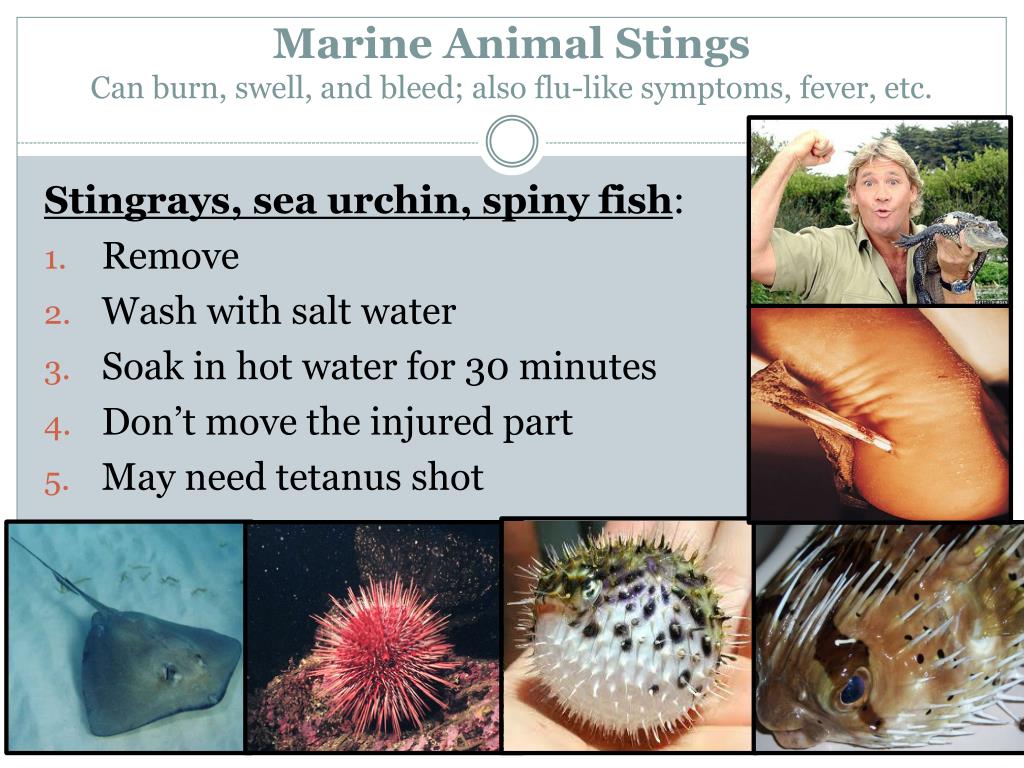
Recognizing Symptoms of Stingray Stings
Stingray stings can cause a range of symptoms, varying in severity. It’s important to be aware of these symptoms to assess the situation and determine if medical attention is required.
Common Symptoms
- Immediate, intense pain at the site of the sting
- Bleeding from the wound
- Swelling and redness around the affected area
- Nausea and vomiting
- Muscle cramps
- Weakness or dizziness
- Anxiety or panic
Severe Symptoms Requiring Immediate Medical Attention
- Difficulty breathing
- Chest pain
- Severe bleeding
- Signs of allergic reaction (hives, swelling of face or throat)
- Loss of consciousness
Can stingray stings cause long-term effects? While most stingray stings heal without complications, in rare cases, they can lead to infections or leave scars. Proper first aid and follow-up care can minimize these risks.
Medical Treatment for Stingray Injuries
While many stingray stings can be treated with first aid at home, some cases require professional medical attention. Here’s what you can expect if you need to visit a healthcare provider:

Assessment and Diagnosis
The medical team will:
- Examine the wound thoroughly
- Check for any remaining pieces of the stinger
- Assess the extent of tissue damage
- Monitor vital signs and look for signs of systemic reaction
Treatment Options
Depending on the severity of the sting, treatment may include:
- Removal of any remaining stinger fragments
- Thorough cleaning and debridement of the wound
- Administration of antibiotics to prevent infection
- Tetanus shot, if needed
- Pain management, which may include local anesthetics or stronger pain medications
- In severe cases, treatment for shock or allergic reactions
When should you seek medical attention for a stingray sting? It’s advisable to see a doctor if:
- The barb is still embedded in the wound
- You experience severe symptoms or signs of allergic reaction
- The pain doesn’t subside after home treatment
- You notice signs of infection (increased redness, swelling, or pus)
- You have a pre-existing medical condition that might complicate healing
Prevention: The Stingray Shuffle and Other Safety Measures
Preventing stingray stings is far easier than treating them. By adopting certain behaviors and awareness, you can significantly reduce your risk of encountering these marine creatures.

The Stingray Shuffle
The most effective technique for avoiding stingray stings is the “stingray shuffle.” Here’s how to do it:
- When entering shallow water, slide your feet along the bottom instead of taking normal steps
- This shuffling motion creates vibrations in the water that alert nearby stingrays to your presence
- Stingrays will typically swim away when they sense these vibrations
Why is the stingray shuffle so effective? Stingrays are naturally shy creatures that prefer to avoid confrontation. The vibrations created by shuffling your feet give them ample warning and opportunity to move away, reducing the chances of accidental contact.
Additional Prevention Tips
- Be aware of your surroundings and watch for signs of stingrays in the water
- Avoid areas known to have high stingray populations, especially during peak seasons
- Wear protective footwear when wading in shallow waters
- Don’t touch or provoke stingrays if you see them
- Pay attention to local warnings or beach flags indicating stingray presence
Comparing Stingray Stings to Other Marine Injuries
While stingray stings are painful and potentially dangerous, they’re not the only hazard swimmers and beachgoers need to be aware of. Understanding how stingray stings compare to other marine injuries can help you prepare for various scenarios.

Jellyfish Stings
Jellyfish stings differ from stingray stings in several ways:
- Mechanism: Jellyfish use thousands of tiny stinging cells on their tentacles, while stingrays have a single barbed stinger
- Symptoms: Jellyfish stings typically cause a burning sensation and visible welts, while stingray stings result in a puncture wound and deep pain
- Treatment: Jellyfish stings are often treated with vinegar or salt water, whereas hot water is the primary treatment for stingray stings
Shark Bites
While much rarer than stingray stings, shark bites are often more severe:
- Mechanism: Sharks bite with their teeth, causing lacerations and potential tissue loss
- Severity: Shark bites are generally more traumatic and can lead to significant blood loss
- Treatment: Shark bites often require immediate medical attention and may necessitate surgical intervention
Are stingray stings more dangerous than jellyfish stings? Generally, stingray stings are considered more severe than most jellyfish stings due to the deeper tissue damage and potential for infection. However, some jellyfish species, like the box jellyfish, can be extremely dangerous and even life-threatening.

Long-Term Care and Recovery from Stingray Stings
While the immediate pain from a stingray sting can be intense, proper care and attention to the wound can ensure a smooth recovery process. Here’s what you need to know about long-term care and potential complications:
Wound Care
After the initial treatment, ongoing wound care is crucial:
- Keep the wound clean and dry
- Change dressings regularly as advised by your healthcare provider
- Watch for signs of infection, such as increased redness, swelling, or discharge
- Avoid swimming or soaking the wound until it has healed
- Follow any specific instructions given by your doctor regarding antibiotic use or follow-up visits
Potential Complications
While most stingray stings heal without issues, be aware of potential complications:
- Infection: The most common complication, which can be prevented with proper wound care
- Scarring: Depending on the depth and location of the wound
- Tissue necrosis: In rare cases, the venom can cause localized tissue death
- Allergic reactions: Some individuals may develop allergies to stingray venom
How long does it take to recover from a stingray sting? Recovery time varies depending on the severity of the sting and individual factors. Most people experience significant pain relief within a few hours of proper treatment. Complete healing of the wound typically takes 1-2 weeks, but can be longer for more severe injuries.

When to Return to Water Activities
Before returning to swimming or other water activities:
- Ensure the wound has completely healed
- Consult with your healthcare provider if you have any doubts
- Consider using protective footwear when re-entering areas known for stingrays
- Be mentally prepared and practice the stingray shuffle to prevent future incidents
By following these guidelines and staying vigilant, you can enjoy your time in the water while minimizing the risk of stingray encounters. Remember, respect for marine life and awareness of your surroundings are key to safe and enjoyable beach experiences.
How to Treat a Stingray Wound
Ahh, the infamous stingray wound. Really the only true solution is hot water, as hot as you can stand. In Seal Beach one summer we treated over 350 stingray wounds, that year the nation reported 1,200 total injuries…I’ve had a little experience with those mean buggers. The sting is a result of a neurotoxin membrane that coats the barb on the stingrays tail. It’s not necessarily the wound that hurts, but more the poison that enters into your blood stream. Basically approach it like this:
1. Always shuffle your feet when walking out to the surf, stingrays are shy and skittish creatures and will generally flutter away at the first sign of danger. The sting is a self-defense mechanism when they get stepped on or threatened. The Stingray Shuffle is your first line of defense.
2. If you do feel something soft and squishy under your foot step off of it as quick as possible. I stepped on a stingray last weekend, but got off it in time that it didn’t get me (thank god because it f**ing hurts!). Step lightly in other words.
If you do feel something soft and squishy under your foot step off of it as quick as possible. I stepped on a stingray last weekend, but got off it in time that it didn’t get me (thank god because it f**ing hurts!). Step lightly in other words.
RELATED: How to Properly Clean and Dress a Reef Cut
3. In the case that you do get stung, come to the beach as quick as possible, don’t panic because it will only increase your circulation, thus aiding in the movement of the toxin through your body. Also you want to try and limit anything that may bring on symptoms of shock.
4. Go home, or to the nearest lifeguard or fire station to treat it. The wound can vary in pain. I’ve had a woman compare it to child birth and seen full-on tattooed gangbangers cry like little sissies; conversely I’ve seen little girls walk away with relatively little discomfort.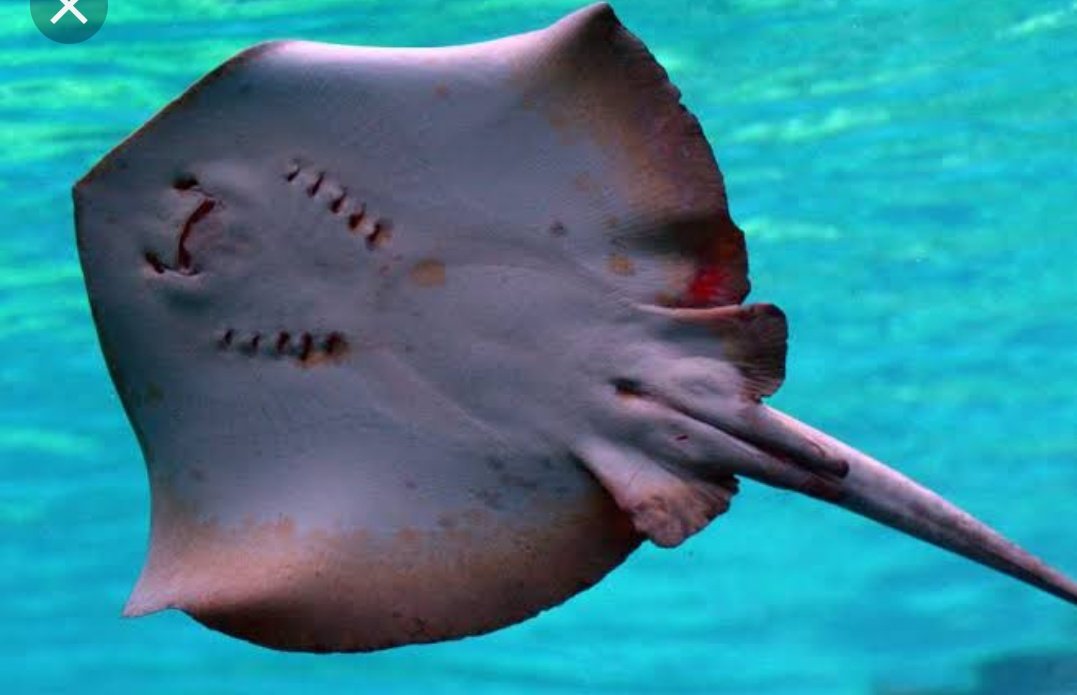 Either way it’s not going to be fun. Pretty much the only real thing you can do for the pain is soak the sting in hot water, as hot as you can stand, but don’t go burnin’ yourself. You can also take Advil or something, but no aspirin. Aspirin thins the blood and allows the toxin to travel easier.
Either way it’s not going to be fun. Pretty much the only real thing you can do for the pain is soak the sting in hot water, as hot as you can stand, but don’t go burnin’ yourself. You can also take Advil or something, but no aspirin. Aspirin thins the blood and allows the toxin to travel easier.
RELATED: How to Avoid Getting Attacked by a Shark
5. Soak the foot until it feels significantly better. The pain probably won’t go completely away, but it should feel dramatically better. A little swelling is normal. Be sure to clean the wound as best as possible. If it looks like the stingray barb is still in your foot see a doctor for treatment. Actually, if anything weird at all goes on go see a doctor.
Know before you go
Start your 15-day free trial to Surfline Premium and start scoring better waves today.
Jellyfish and Stingray Stings — When to Go to the ER
Most jellyfish stings are harmless and occur by accident when people come in contact with the tentacles.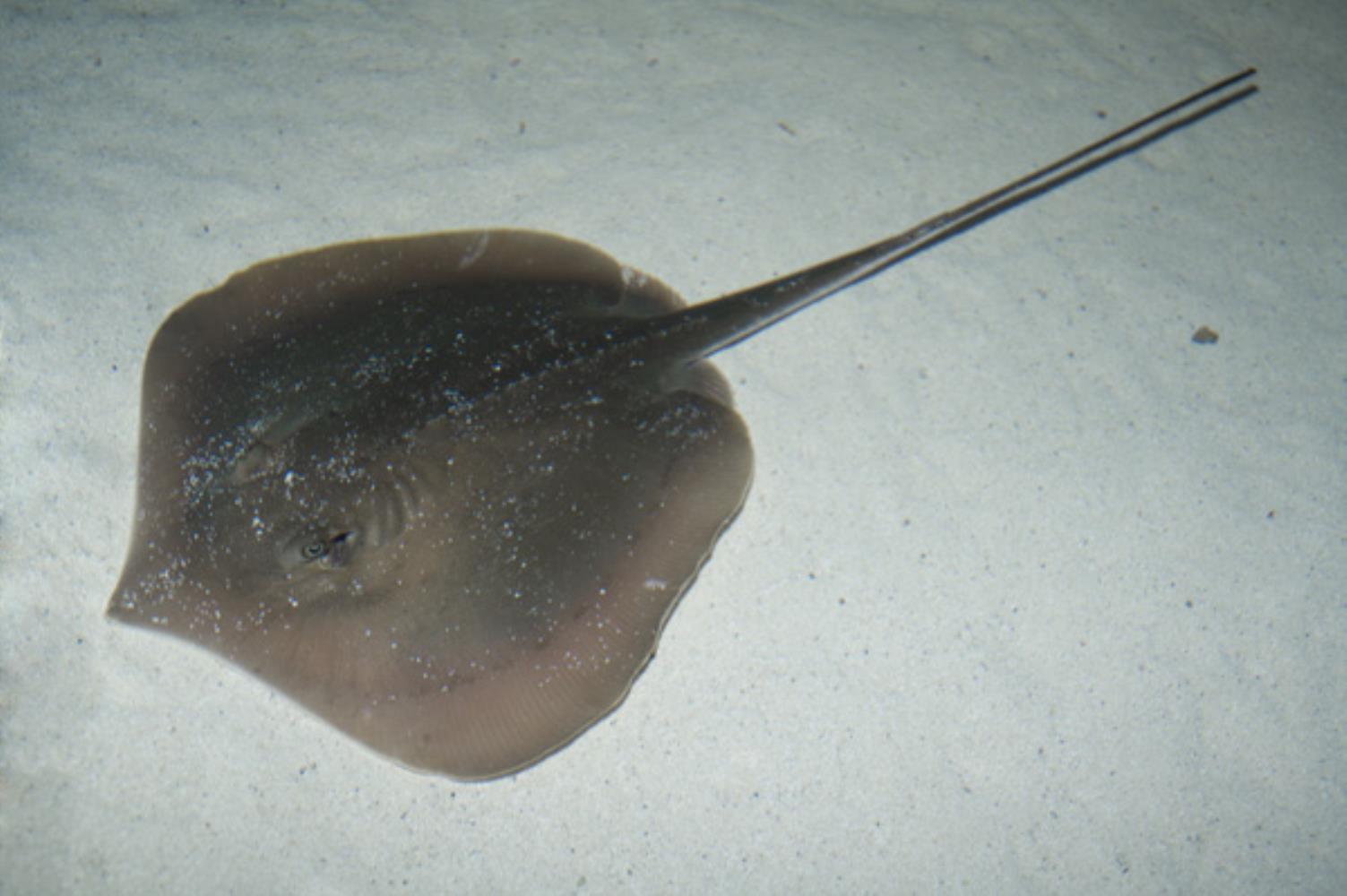 Some varieties of jellyfish are more poisonous than others, such as the box jellyfish from Australia. Most stingray injuries require emergency care. To prevent injury, avoid swimming in areas where there are sightings of jellyfish or stingrays.
Some varieties of jellyfish are more poisonous than others, such as the box jellyfish from Australia. Most stingray injuries require emergency care. To prevent injury, avoid swimming in areas where there are sightings of jellyfish or stingrays.
Jellyfish tentacles release thousands of very tiny stinging cells (nematocysts) that attach to the surface of the skin releasing venom, whereas, the stingray uses its hard barbed tail that is serrated with small venom-containing spines that penetrate the skin.
The tentacles of a jellyfish release a poison that results in a skin eruption, in the form of a painful red rash that itches. The sting usually causes a sting mark, pain and swelling, which may last several days to several weeks. Both jellyfish and stingray stings also can cause life-threatening shock and allergic reactions.
The sting of a stingray causes a bleeding wound that may become swollen and turn blue or red. It causes excruciating pain and can result in death. Severe symptoms may include nausea, fever, muscle cramps, paralysis, elevated heart rate and seizures.
Severe symptoms may include nausea, fever, muscle cramps, paralysis, elevated heart rate and seizures.
If stung by a jellyfish or stingray:
- Carefully remove any tentacles or stingers still on the body. Make sure to cover your hand or use a tool — do not directly touch the tentacles or you will be injured.
- Soak jellyfish stings in salt water or vinegar (fresh water will increase pain and may release more of the toxin).
- Soak stingray stings in hot (but not scalding) water until the pain diminishes.
- Wash and bandage.
- For stingray stings, apply pressure to stop the bleeding. If necessary, and you are trained to do so, perform CPR.
- If an allergic or life-threatening reaction is observed, call 911 or your local emergency number immediately.
First aid: How to treat stingray, jellyfish and bee stings
Encounters with wildlife can be enriching and educational moments that remind us just how dependent we are on nature. Just ask the many hiking converts who have been hitting Bukit Timah Nature Reserve to walk off cabin fever and the pandemic angst, or the beach lovers who have been wading into Sentosa’s waters to cool off.
Just ask the many hiking converts who have been hitting Bukit Timah Nature Reserve to walk off cabin fever and the pandemic angst, or the beach lovers who have been wading into Sentosa’s waters to cool off.
But sometimes, these encounters can elicit painful experiences, such as the unfortunate stingray incident at Tanjong Beach or last year’s jellyfish episode at Palawan Beach.
Advertisement
Advertisement
“Allergic reactions are one of the most feared complications arising from any sting,” said Dr Jonathan Chong from DTAP Clinic. Signs of an allergic reaction include a generalised rash over the body, difficulty breathing, and swelling of the face, eyes and neck, he said.
These signs can develop rapidly over the course of a few minutes and can be lethal, he added, referring to the life-threatening condition known as anaphylaxis.
READ: My real-life experience with jellyfish stings: What worked and what didn’t
However, if the symptoms are mild and self-limiting, and there are no stingers in the skin, said Dr Chong, self-treatment is possible.
Advertisement
Advertisement
How, then, do you treat such wounds? Do you try to remove the stinger? And what is the best way to minimise the pain? Here’s what to do if you accidentally get on nature’s wrong side and get stung.
STINGRAY STING
The damage: The barb near the base of a stingray’s tail is like a sheathed, serrated blade with venom glands. According to a report on injuries by marine creatures published in the Singapore Medical Journal (SMJ), when the barb pierces flesh, the sheath breaks, allowing venom to enter the wound.
Advertisement
The venom causes blood vessels to constrict and the resulting poor blood circulation and lack of oxygen can lead to the skin turning blue and the affected tissues to die.
Explained Dr Chong: “Stings from stingrays will often result in a combination of a puncture wound and a cut in the skin. The pain can persist for hours, is often severe and can radiate up the affected limb.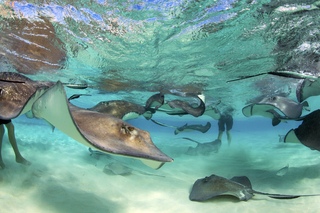 There is usually also profuse bleeding from the wound”.
There is usually also profuse bleeding from the wound”.
There may also be symptoms like nausea, vomiting, diarrhoea, cold sweat, fainting or seizures, according to Dr Keith Ho, the chief of the Urgent Care Centre at Alexandra Hospital.
In our practice, bee stings are far more commonly encountered than stingray or jellyfish stings.
First aid action: The first thing to do is to get the victim out of the water, and either call for the lifeguard or an ambulance, said Dr Chong. Check that the victim’s airway is not blocked and he is still breathing; otherwise, a trained person should perform cardiopulmonary resuscitation or CPR.
“Visible, superficial stingray barbs or debris can be removed with a pair of tweezers or by hand,” said Dr Chong. However, if it’s a deep, puncture wound, especially in the neck, chest or abdomen, do not attempt to remove the barb but let the emergency medical team handle it, he cautioned.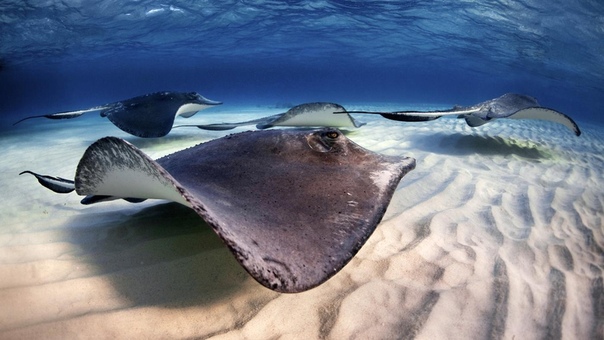
(Photo: Pexels/Skitterphoto)
To reduce the pain, Dr Chong recommended immersing the affected limb in hot water (40 to 45 degrees Celsius). “A hot shower is also possible,” he said. If hot water is not available, apply a heat pack on the wound. Otherwise, use a cold pack or make one by wrapping ice in a dry plastic bag instead.
Chances for self-treatment are low, according to Dr Ho, as stingray wounds generally require a tetanus shot (if yours isn’t up to date) – and an inspection of the injured area for any foreign body, non-viable tissue and severity of infection.
JELLYFISH STING
The damage: Jellyfishes’ gelatinous domes are usually harmless but touch their trailing tentacles and you can expect a world of pain. The burning, stinging sensation that results is caused by several million stinging cells launching spirally-coiled threads – each ending with a toxin-containing barb – into your skin when touched, said Dr Ho.
(Photo: Pexels/Porapak Apichodilok)
In fact, this very function of the stinging cells does not cease even when the jellyfish is washed up on the beach – or even when its tentacles are still attached to your skin. This is why, according to the SMJ report, you should not scratch, rub or wash the affected area with fresh water as it may activate undischarged stingers and cause further damage.
First aid action: Help the person out of the water immediately and call 995, advised the National Parks Board (NParks). While waiting for medical help to arrive, keep the person calm and still to minimise the tentacles from further discharging venom.
To reduce the pain, apply vinegar directly to the wound, either by dousing or spraying, for about 30 seconds to deactivate the stingers, said Dr Chong. NParks noted that if the vinegar worsens the pain (non-box jellyfish stings may get more painful), stop using it and just flush with seawater. But do not apply fresh water, urine or other substances.
But do not apply fresh water, urine or other substances.
(Photo: Freepik/valuavitaly)
After that, proceed to pluck visible tentacles off the skin and rinse the area with seawater, said Dr Chong. Do not rub the sting site to get the tentacles off as that may worsen the pain. A word of caution: If you don’t have tweezers and are picking the tentacles off with your bare fingers, you may feel a light stinging sensation. Rinse your hands with seawater when you are done.
BEE STING
The damage: “In our practice, bee stings are far more commonly encountered than stingray or jellyfish stings,” said Dr Chong, who sees two to four patients with bee stings a week, especially younger children.
If you are not allergic to bee stings, the encounter is actually more fatal for the bee – if it’s a honey bee – than for you. That’s because honey bees have barbed stingers that get stuck in your skin after stinging you.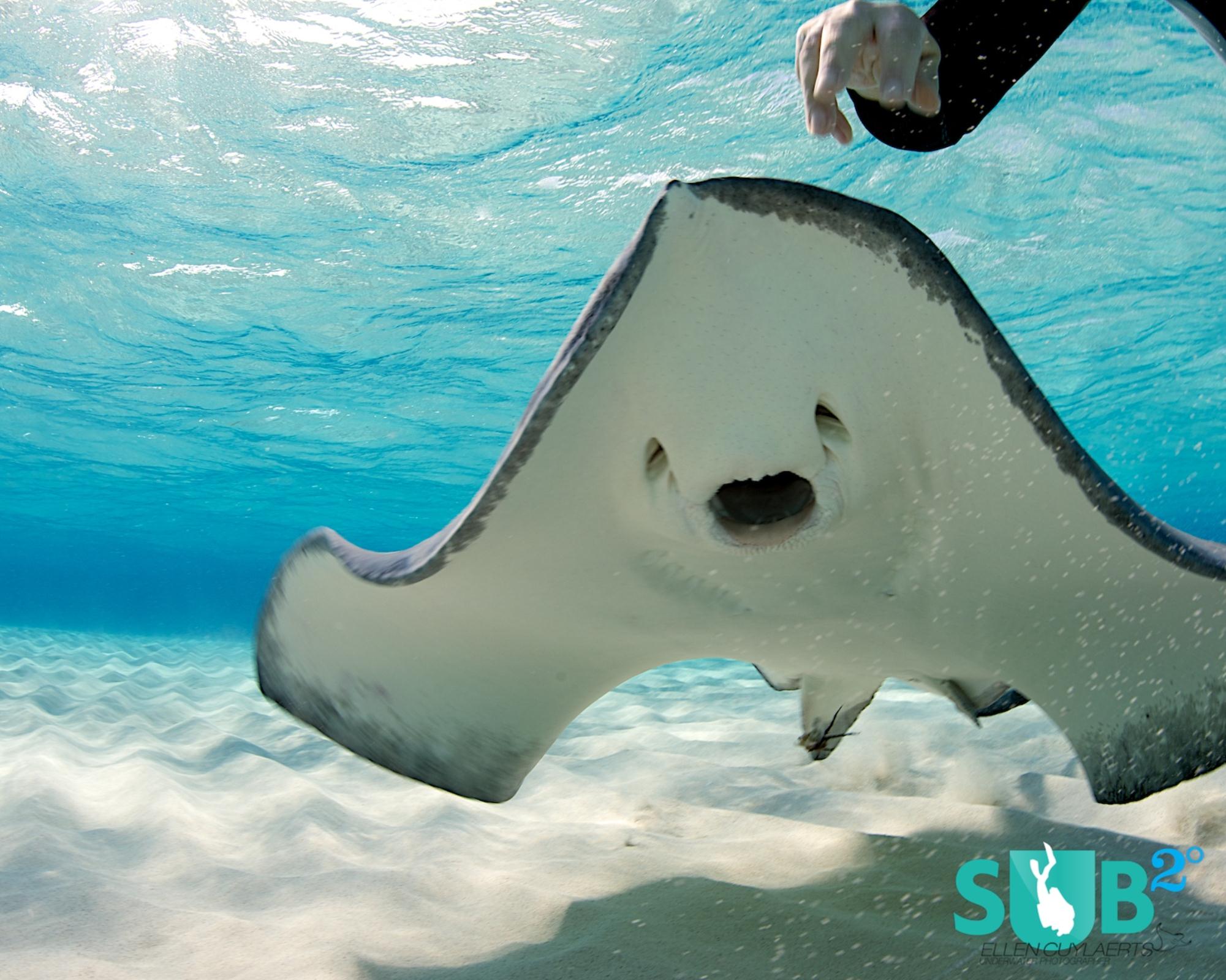 To get away, the bee has to disembowel itself and dies. Wasps, hornets and other bees are spared this fate as their stingers are not barbed – which also means they can sting multiple times.
To get away, the bee has to disembowel itself and dies. Wasps, hornets and other bees are spared this fate as their stingers are not barbed – which also means they can sting multiple times.
(Photo: Pexels/David Hablutzel)
The venom, which contains components that cause pain, itching, allergic reactions and damage to the tissues, is released in the first few seconds of stinging. You get a red, painful and itchy bump; or anaphylaxis if you are allergic to the venom, said Dr Ho.
“About 10 per cent of people may have a stronger reaction, developing more pronounced redness and swelling over the sting site that gradually enlarges over one to two days,” said Dr Chong. “This can take up to 10 days to subside.”
Nevertheless, Dr Ho noted that generally, you can self-treat bee stings “if there are only a few stings, the local reaction is small, and the pain or itch minimal”. “Medical attention is generally required if there are multiple stings (risks of kidney and/or liver failure, or muscle breakdown) or signs of anaphylaxis (rash, hoarse voice, abdominal symptoms, breathing difficulties and/or fainting). “
“
First aid action: If a stinger is left behind in the wound, scrape it out by using the edge of a credit card as soon as possible, advised Dr Ho.
To reduce the pain, Dr Chong recommended washing the affected area with soap and water, and applying a cold pack to the sting site. “If the sting is on an arm or a leg, elevation of the affected limb may help to reduce pain and swelling as well.”
Then, observe the victim for signs of serious allergic reactions, which would require immediate medical attention.
Avoiding, Treating Stingray Injuries – CHOC Children’s Blog
As beach season kicks into high gear, swimmers, surfers and sunbathers of all ages should be mindful that one wrong step can turn a fun beach day into a total wipeout.
Unwitting beach goers can easily get stung by a stingray when they inadvertently step on the creatures while walking though waters. Lurking stingrays are often invisible because they burrow and blend in well with the sand in shallow waters.
When disturbed, the ray flips up its sharp tale and can pierce the swimmer’s leg, foot or ankle. Though not venomous, the stings are painful and the stinger’s puncture wound poses a risk of infection or allergic reaction, says Sheryl Riccardi, a registered nurse and clinical educator in the Julia and George Argyros Emergency Department at CHOC.
Treatment for stings is simple, Sheryl says. First, parents of children who have been stung should remove the stinger. Next, soak the wounded area in hot water until the pain is gone. Other methods to remove the stinging sensation include a vinegar rinse or baking soda paste, as well as over-the-counter pain relievers.
Stings should be reported to lifeguards, and parents of stung children should seek further medical treatment if the wound is still store or burning about 24 hours after the sting occurs, Sheryl says.
Though particularly common in areas with long beaches and shallow waters, stings can be prevented.
Try practicing what lifeguards call the “stingray shuffle.” Instead of taking full steps through shallow waters, drag feet across the sand. The goal is to gently disturb a burrowed ray so that it will swim away. Stepping on top of the creature will frighten it and increase the likelihood of an attack.
While much less common in Orange County than in other U.S. waters, jellyfish stings should be handled in the same manner as stingray stings.
Related posts:
Summer Safety: What’s in Sunscreen?
By Melody Sun, clinical pharmacist at CHOC
The skin is the largest organ of the body, and our best protection against the outside environment. Sunlight stimulates the skin to produce vitamin …Child Passenger Safety Tips for Your Next Vacation
Finding the right car seat for your little passenger is an important task for all parents. Recent legislation states all children in California must be in rear-facing car seats until .
 ..
..Keeping Kids Active This Summer
By Michael Molina, MPH, Community Educator at CHOC
Children and adolescents should meet a minimum of 60 minutes of physical activity every day. The full 60 minutes doesn’t have to be …
How to avoid stingrays, what to do if stung
One North Carolina beach has seen an average of at least one stingray injury per day for a month.
EMS crews said they responded to four people stung by rays in the last five days at North Topsail, WITN reported.
North Topsail Beach Deputy Fire Chief Bill Poe warned beachgoers that the town has received about 40 calls related to stingray injuries in the past month, WNCT reported.
While there may be more rays spotted on Carolina beaches in the summer — and more stings — there isn’t necessarily a “stingray season,” Joel Fodrie, an associate professor at the University of North Carolina at Chapel Hill Institute of Marine Sciences, told The News & Observer on August 14.
“There’s a peak season for people to be at the beach and in the water, where rays are year-round,” Fodrie said. “So that’s a peak season for people and rays to meet in the surf zone. But there’s not really a ‘stingray season.’ I suspect it’s defined by people as much as rays.”
While most rays are present in Carolina waters throughout the year, Cownose rays can be seen in schools off the coast of the Carolinas right before migrating south to South America for the winter. Some videos have captured hundreds or thousands of them grouped together, Fodrie said.
Types of Carolina rays
There are about 10 species of ray that make North Carolina their home, Fodrie said. The most common of those, in general order of smallest to largest are:
▪ Atlantic stingrays: Somewhat smaller with more pointed snouts, these rays usually spend time buried in the sand or mud of shallow water.
▪ Southern stingrays: Slightly larger than Atlantics usually, with a more serious barb.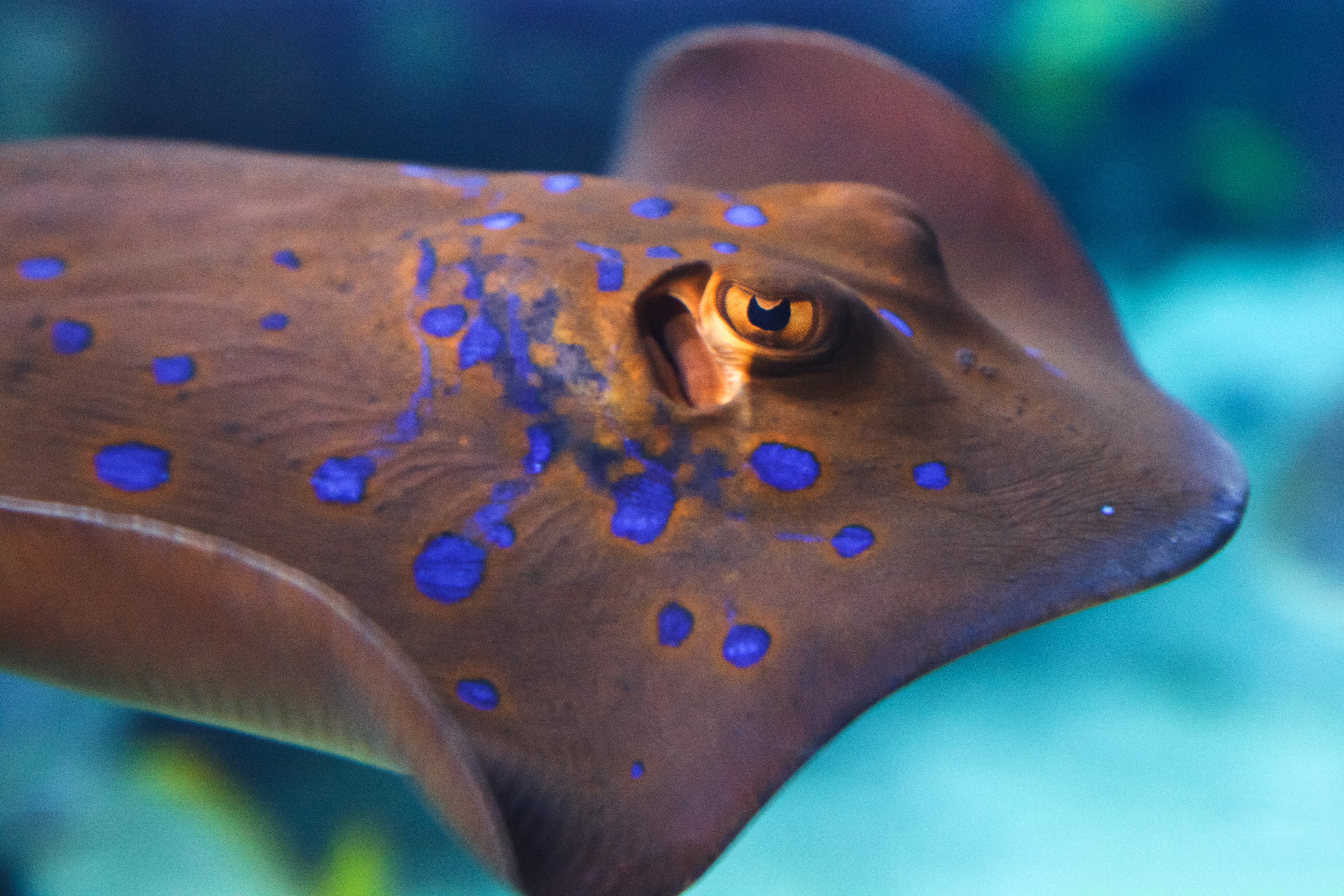
▪ Bluntnose stingrays: A bit rarer in the Carolinas, found hunting in the mud in shallower water.
▪ Cownose and bullnose stingrays: Unlike smaller rays, these don’t lay on the bottom, and instead swim freely, often in deeper water. Their barbs also are not on their tails, but further up on their bodies.
▪ Roughtail and spotted eagle rays: Found in deeper water (more than 6 feet) these rays are much larger, reaching 10 feet or more.
Also present in Carolina waters are skates and butterfly rays, which don’t have stingers.
Beachgoers are most likely to encounter the smaller Atlantic and southern rays, which can be about the size of a dinner plate, though southern rays can grow as wide as a doormat, Fodrie said.
Cownose can grow to nearly 3 feet, while roughtail can be as wide across as a car.
“They can get pretty doggone beefy,” Fodrie said. “And their stinger is like a full-blown dagger. I would hate to get poked by one of those.”
The good news for beachgoers is those larger rays are found in much deeper waters than the average swimmer spends time in, Fodrie said.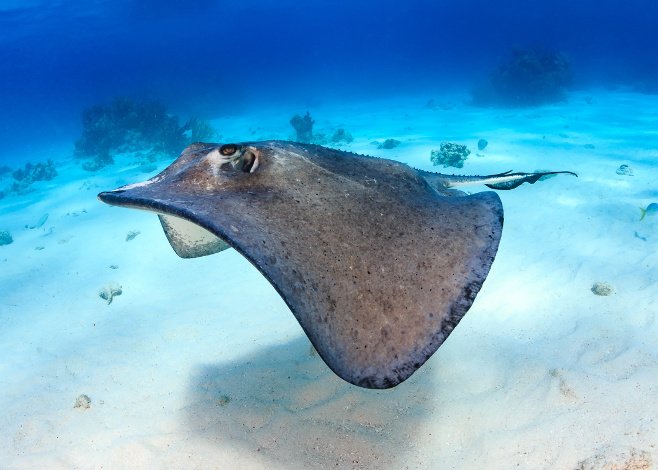
But the smaller rays that spend their time hidden in the sand and mud of shallow waters are in danger of being stepped on at the beach.
How to avoid rays, and what to do if stung
In the calmer water of the North Carolina sounds, rays can see people coming and “get out of Dodge” quickly before being stepped on, Fodrie said. Less so at the beach.
“They don’t enjoy being stepped on,” he said. “It’s dangerous for them. But on the beach it’s harder.”
There’s more noise and commotion at a beach full of people wading in the shallows and visibility can be worse, so the rays can’t get out of the way in time.
“Some of their sensory abilities are muted,” Fodrie said. “And that’s when someone steps on them and gets stung.”
Rays that most often sting people spend their time buried flat in the mud and sand where they dig “ray pits,” Fodrie said. In their pits, they sift for food such as crustaceans, bivalves and worms. They’ll also scavenge for their meals.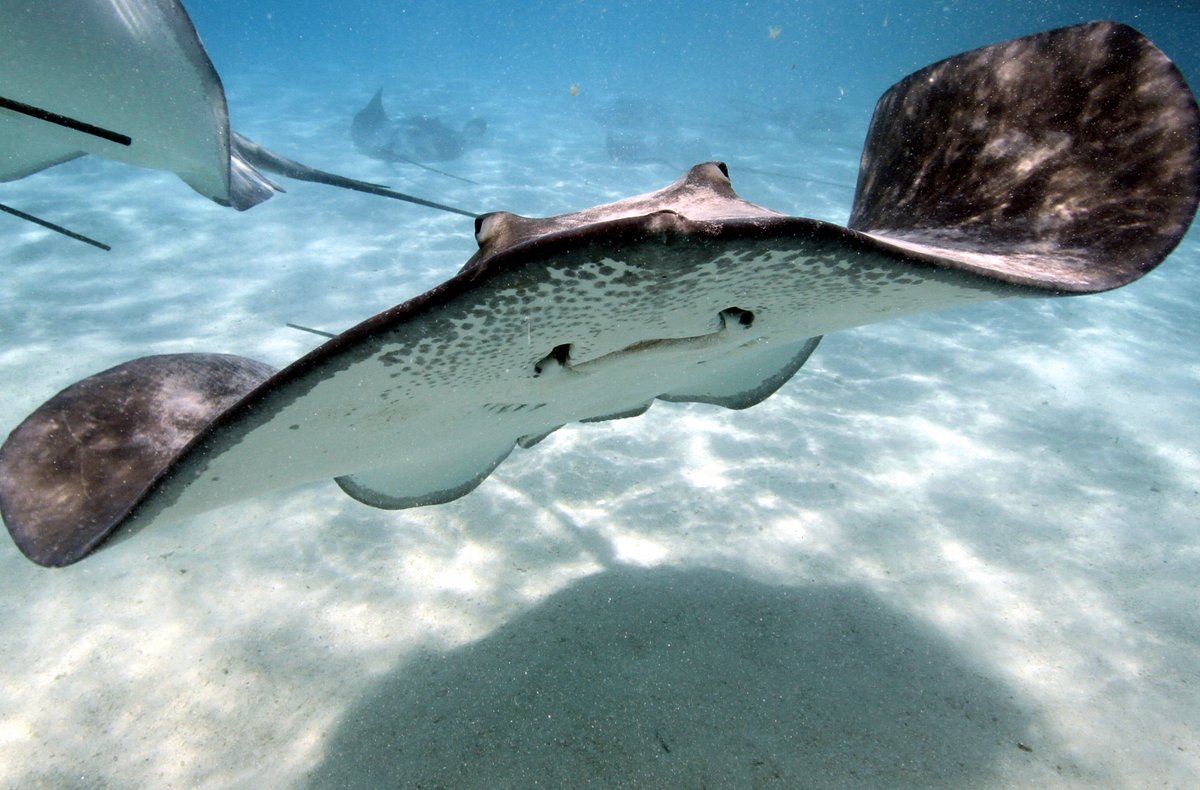 But since they’re in shallow water where people wade, and because they’re often covered in sand or difficult to see, they can be stepped on.
But since they’re in shallow water where people wade, and because they’re often covered in sand or difficult to see, they can be stepped on.
The best way to avoid being stung by a ray is to slowly shuffle your feet as you’re walking or wading in the water and make noise so the rays are warned and can get out of the way, Fodrie said.
And if you’re stung, ice won’t be much help.
“It does nothing for the pain,” Fodrie said. “The trick is to get somewhere you can put hot water on the sting. It can almost immediately eliminate the pain.”
That’s because hot water can break down the proteins that make up the ray’s venom, he said.
If the ray’s barb is broken off in the wound, it may be difficult to remove. That would be a good time to go to the hospital, Fodrie said.
“Barbs are certainly pretty nasty and they won’t just fall out on their own,” he said. “You’d want to get help then.”
If you are stung and pain persists despite hot water treatment, or if you believe you may be having an allergic reaction, seek immediate medical attention.
Nature’s vacuum cleaners
Since rays are scavengers, they make “good vacuum cleaners” in the ocean for dead, weak or sick animals, Fodrie said.
In digging their pits, rays also disturb flat, unstructured parts of the ocean floor, feeding and clearing out some creatures and making room for others or changing the environment, Fodrie said.
“They’re establishing and regulating communities down there in the mud,” Fodrie said.
Rays are also important food sources for apex predators including sharks, dolphins and turtles, Fodrie said.
“They’re an important level of our ocean ecosystems,” he said. “They have a profound impact.”
Related stories from Charlotte Observer
Treating Stingray Stings
– Panama Jack
©istockphoto/qldian
While shark attacks seem to get all the hype, stingray stings are actually among some of the most common beach-related injuries. Nearly 1,500 stingray “attacks” are reported every year, and as many know, it was a stingray that was famously responsible for the untimely death of Australian wildlife expert Steve Irwin, aka “The Crocodile Hunter. ” Wise beach-goers are aware the ocean and its inhabitants have a code all their own, yet sometimes all the caution in the world can still land you on Mother Nature’s bad side. If you happen to find yourself on the receiving end of a stingray sting, don’t panic. They’re painful, but usually not deadly.
” Wise beach-goers are aware the ocean and its inhabitants have a code all their own, yet sometimes all the caution in the world can still land you on Mother Nature’s bad side. If you happen to find yourself on the receiving end of a stingray sting, don’t panic. They’re painful, but usually not deadly.
Identification
If you are stung, you’ll probably feel a very sharp, concentrated pain. First, try to identify the source. Chances are the threatened animal and/or offending object already made a getaway and visibility is often poor in salt water. However, it’s best to collect as much information as possible in order to access the type of treatment you’ll need.
Symptoms
Stingray punctures usually occur on the foot or leg and bleed easily. The area around the wound will most likely swell and may even bruise or turn blue or red. Get out of the water immediately and cleanse the affected area with fresh water. Keep in mind a stingray’s barb is not only sharp, but also covered in a film of venom, so it’s not unlikely the pain will increase as your body begins to react to the toxins.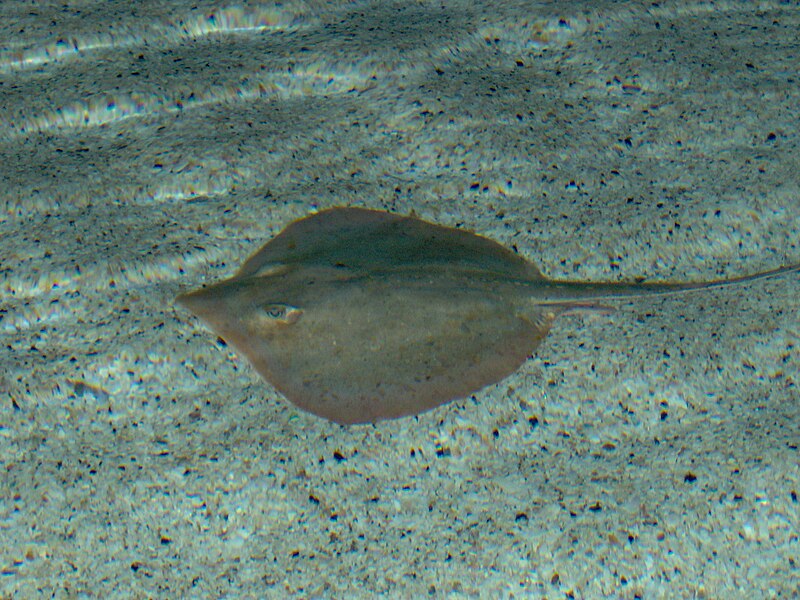 Lymph nodes in the leg especially may become swollen and you may experience muscle cramps, nausea, tremors or potentially even seizures. Go the nearest lifeguard station or urgent care for medical care.
Lymph nodes in the leg especially may become swollen and you may experience muscle cramps, nausea, tremors or potentially even seizures. Go the nearest lifeguard station or urgent care for medical care.
©istockphoto/qldian
Treatment
Treating stingray wounds requires submerging the affected area in water as hot as the individual can stand, around 110 degrees. If portions of the barb are not lodged into the wound, this type of treatment can potentially be done at home instead of the doctor’s office; however, it’s important to note, if the barb is deeply lodged into the skin and/or the area does not seem to be healing, a trip to the emergency room and some antibiotics are in order. Carefully remove any surface debris from the wound with tweezers and continue to soak the area in hot water until the severity of the pain has subsided. Make sure to monitor the pain and the wound area to make sure it’s not worsening.
Prevention
Learning the “stingray shuffle” is your best bet to prevent stings. Once in the water, slide your feet along the sand instead of taking steps. This sliding motion sends vibrations through the sand, signalling buried rays there’s company and allows them an opportunity to move instead of reacting with a sting when surprised.
Once in the water, slide your feet along the sand instead of taking steps. This sliding motion sends vibrations through the sand, signalling buried rays there’s company and allows them an opportunity to move instead of reacting with a sting when surprised.
Marine Bite Or Sting
You’re most likely to contact biting or stinging marine life while swimming or wading in saltwater. These include jellyfish and coral, as well as sculpins, stingrays, and many other kinds of fish. Most don’t attack people. But they may bite or sting if they are stepped on or touched. Even a dead jellyfish can release poison (venom) when handled. In North America, most marine animal bites or stings aren’t deadly. But they can be painful. They can be serious if the wound is deep, becomes infected, or causes an allergic reaction.
Your injury will be cleaned and examined. Bite or puncture wounds are often not closed with stitches. A jellyfish sting may be rinsed with sterile saline solution or vinegar. This prevents more toxins from being released. Applying heat to the area may also help accomplish this task. Any tentacles left in your skin will be removed. It’s better to remove them after inactivating them so they don’t release more toxin when handled. If stingray barbs are present, they need to be removed. If you have an allergic reaction that is severe, you may be given a steroid medicine to help control it. If you are in pain, medicine may be prescribed to make you more comfortable. Blood tests, ultrasound, wound culture, or X-rays may be done to check for other injuries or signs of infection. Treatment will depend on the location and severity of the wound.
This prevents more toxins from being released. Applying heat to the area may also help accomplish this task. Any tentacles left in your skin will be removed. It’s better to remove them after inactivating them so they don’t release more toxin when handled. If stingray barbs are present, they need to be removed. If you have an allergic reaction that is severe, you may be given a steroid medicine to help control it. If you are in pain, medicine may be prescribed to make you more comfortable. Blood tests, ultrasound, wound culture, or X-rays may be done to check for other injuries or signs of infection. Treatment will depend on the location and severity of the wound.
Home care
Your healthcare provider may prescribe medicines to help ease pain and prevent infection. Follow your provider’s instructions for taking these medicines. If antibiotics have been prescribed, finish all of the medicine until it is gone, even if you feel better.
General care
Wash your hands with soap and warm water before and after caring for the wound.

Clean the wound with mild soap and water and pat dry. Do this as often as instructed by the provider.
Watch for signs of infection, including fever, increasing pain, redness, or pus (discharge).
If bleeding occurs, apply gentle, even pressure.
Cover the wound with a new, clean bandage. Apply the bandage snugly, but not too tight. Keep the bandage clean and dry.
Get plenty of rest and fluids.
To prevent future stings, never handle any marine life. Even dead jellyfish on the beach can cause stings.
Follow-up care
Follow up with your healthcare provider, or as advised.
When to get medical advice
Call your healthcare provider or get medical care right away if any of these occur:
Swelling of the affected body part, hands, or face
A feeling that there is something in the wound
Fever of 100.4°F (38°C) or higher, or as directed by your provider
Signs of infection, including increasing pain, increasing redness or swelling, or discharge from the wound
Numbness or tingling in the area of the wound
Pain that does not get better after taking medicine, or gets worse
Your wound isn’t healing
Call
911
Call 911 if any of these occur:
90,000 What to do if bitten by a stingray – Bitten!
Stingray stingrays are a family of cartilaginous fish that belongs to the stingray order.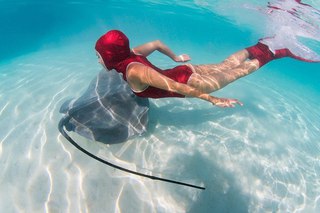 They live in almost all seas and oceans. They feel great in a very wide temperature range, from 1.5 ° C to 30 ° C. Some species are common in shallow waters, others are found at depths of up to 2500 meters. There are even stingrays that prefer to live in fresh water.
They live in almost all seas and oceans. They feel great in a very wide temperature range, from 1.5 ° C to 30 ° C. Some species are common in shallow waters, others are found at depths of up to 2500 meters. There are even stingrays that prefer to live in fresh water.
Stingray stingray
Stingray stingrays have a well-defined tail, which by its appearance resembles a whip.In some species, its length exceeds half the total length of the fish. The tail ends with one or two serrated spines, along which grooves with venom glands often run. The length of the spike can be up to 37 cm. Thanks to the powerful tail muscles and extremely hard spikes, the ramp can easily pierce a wetsuit, a leg, and the bottom of a wooden boat.
It is noteworthy that the stingray uses its tail exclusively for self-defense, since its more than modest teeth are completely unable to cope with such protective functions.When a danger arises, the stingray stingray makes sharp lunges up and forward with its tail, and the spike pierces the enemy.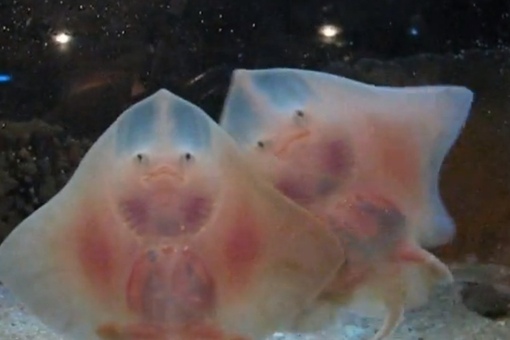
How to protect yourself from contact with stingray-stingray
Stingray spike tip
Firstly, in places where rays are spread, enter the water gradually, do not sneak, while shuffling along the bottom with your feet in order to scare away a hunter who could bury himself in the sand in anticipation of a suitable lunch. Take special care in shallow bays, river estuaries, near beaches, that is, in places that stingrayers choose for their hunt.
Secondly, swim in special shoes.
Third, do not go into the water at night.
Fourth, be vigilant while diving, do not tease or pester the rays.
Fifth, when you find a stingray-stingray, make some noise, wave your foot several times under water, try to scare it away.
Sixth, carefully cut the stingray carcass when using it for culinary purposes. Even the poison of a dead stingray continues to pose a danger to humans.
What are the consequences of a stingray injection
The venom of stingrays has a neurotropic effect, causing instant burning and throbbing pain in the damaged area, the peak of which is observed after 1-1.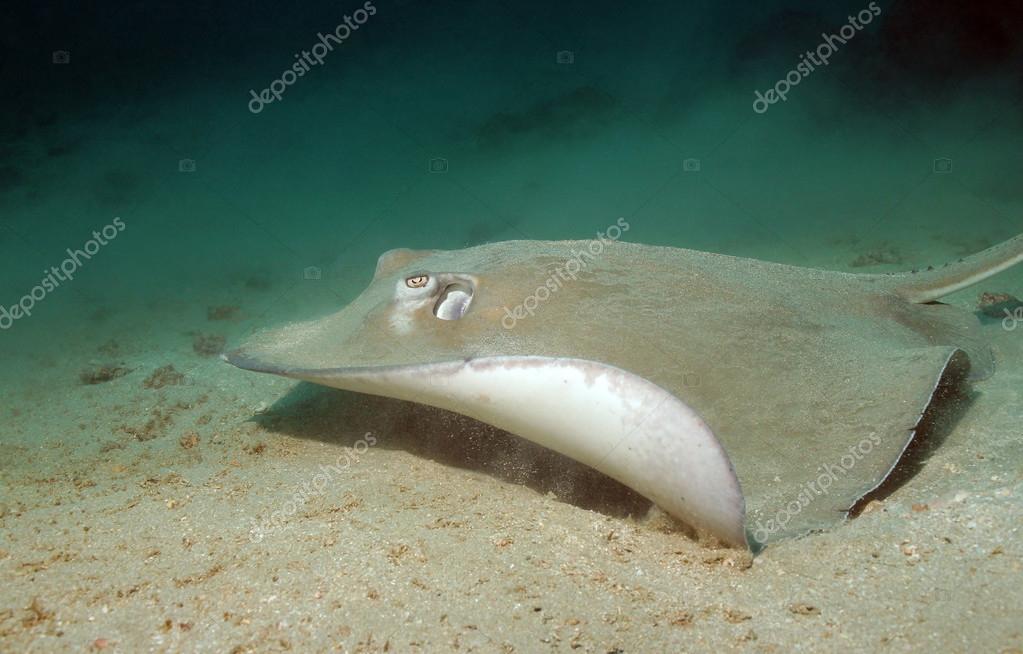 5 hours. Painful sensations can persist for several days, gradually fading away over the next 6-48 hours. They are so pronounced that the victims start screaming and rushing about. In such cases, even loss of consciousness is possible.
5 hours. Painful sensations can persist for several days, gradually fading away over the next 6-48 hours. They are so pronounced that the victims start screaming and rushing about. In such cases, even loss of consciousness is possible.
Contact with a stingray, in addition to pain, is also accompanied by the following symptoms:
- blanching and subsequent redness or blue discoloration of the skin around the wound,
- nausea,
- vertigo,
- chills,
- increase in body temperature,
- weakness,
- drop in blood pressure,
- a sharp increase in heart rate,
- the appearance of a feeling of anxiety.
Stingray in water
Less commonly, lymph nodes may swell, sweating increases, painful sensations in the groin and armpits, vomiting and diarrhea may occur. In severe cases, there is a high likelihood of seizures, respiratory failure, the victim may be delirious, lose consciousness.
The greatest danger is represented by large individuals, which have a large amount of poison and a powerful thorn. The fatal outcome is observed mainly when injured in the chest or abdomen.
Plus, a stingray spike usually results in a laceration that bleeds profusely.Debris from its covering can remain in the wound, thereby increasing the risk of infection. In this case, the color of the edges of the wound often changes, tissues are destroyed, and pronounced edema appears.
What not to do when pricking a stingray
In no case should you jerk out spike fragments stuck in the wound. If removed incorrectly, the teeth on the spike can cause additional injury to the victim.
Don’t cut the wounds either. Such actions do not ensure the elimination of the poison, but only unnecessarily injure the victim.
It is not recommended to cauterize the damaged area, as this is fraught with the same sad consequences that were discussed in the previous paragraphs.
Do not inject a solution of potassium permanganate or any other strong oxidizing agents into the wound.
It is forbidden to consume alcoholic beverages that only aggravate the situation, accelerating the spread and absorption of the poison.
What measures can be taken when pricking a stingray
While waiting for a doctor or on the way to the nearest medical facility, the victim can and should be given first aid.
1. First of all, you should suck out the poison from small puncture wounds during the first 10 minutes after the injection, periodically spitting it out. This can be done only in the absence of any damage in the suction mouth. At the end of the procedure, the mouth must be rinsed with a solution of potassium permanganate or simply with clean water.
2. To reduce the concentration of poison and ease painful sensations, the wound should also be rinsed with sea water in large quantities.
3.After that, you should carefully remove the remaining spike fragments, which are directed backward. In this case, they should be fed slightly forward and slightly turned to unhook the prong from the fabric, and only then remove.
In this case, they should be fed slightly forward and slightly turned to unhook the prong from the fabric, and only then remove.
4. Hot baths are recommended. First, you should apply a pressure bandage above the wound and lower the pricked limb for 30-60 minutes in hot water, the temperature of which is slightly below the burn threshold. 3% magnesium sulfate can be added to the water. The pressure bandage should be loosened and retightened every 10 minutes.
5. Finally, an antiseptic bandage should be applied and the limb should be immobilized.
Interesting Stingray Stingray Facts
- On the coast of North America, about 750 people suffer from stingrays every year.
- Lethal outcomes are recorded in 1% of cases of contact with stingray stingrays.
- The contact with the stingray was deadly for the popular Australian naturalist and TV presenter Steve Irwin.
- Indians, Malays, Australian Aborigines and the Pacific and Indian Oceans used stingray spikes as arrowheads for their spears and arrows.
 And since during its life a stingray can grow a new thorn several times, the natives even engaged in the cultivation of stingrays.
And since during its life a stingray can grow a new thorn several times, the natives even engaged in the cultivation of stingrays. - Pliny the Elder, in his Natural History, compared the thorn of a stalker to a formidable weapon that can kill wood and pierce armor.
90,000 Stingrays hit without missing – Safetravels.info
There are fifteen families of stingrays, but the average tourist most often encounters stingrays that he needs to be wary of.The name itself suggests that their whip-shaped tail is used as a weapon. Stingrays are color-matched to the color of the environment, making them difficult to spot against the bottom. Swimming at the very bottom or digging up the sand with their fins, they look for small animals: worms, crustaceans, mollusks, which they feed on.
Distribution area. Stingrays can be seen off the coast of Europe, Africa, America and Australia. They live not only in the salty waters of the seas, but also in the mouths of rivers and even in fresh waters in the rivers of South America, Central Africa and Indochina.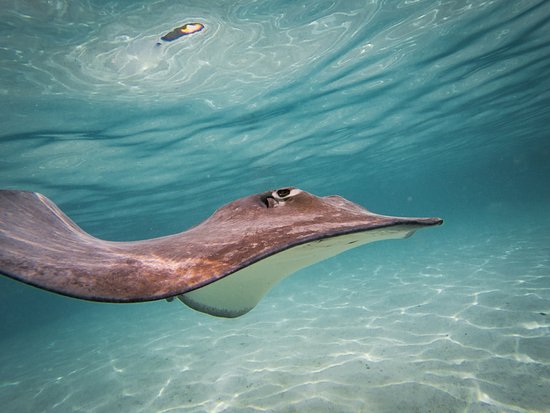 Fish of this family are found from the latitudes of the Baltic Sea to the middle latitudes of South America, including the Mediterranean, Black, Azov and Baltic seas. In the Russian seas, one of the most common species is found – the common stingray (lat.Dasyatis pastinaca). It is also called the sea cat. It can have two or three spines on its tail.
Fish of this family are found from the latitudes of the Baltic Sea to the middle latitudes of South America, including the Mediterranean, Black, Azov and Baltic seas. In the Russian seas, one of the most common species is found – the common stingray (lat.Dasyatis pastinaca). It is also called the sea cat. It can have two or three spines on its tail.
Stingrays usually stay in shallow water near the coast and often swim to the very coast. Favorite spots: shallow bays, coastlines along beaches and estuaries with sandy or muddy bottoms – here they burrow into the sand in search of their prey.
What is dangerous. People often become victims of hidden stingrays. If an unsuspecting person steps on a stingray disguised in shallow water, he receives a blow with his tail, on which long poisonous thorns are located. In large stingrays, the length of the spine can reach 37 cm. The spines are provided with teeth, and the grooves of the spines contain venom. There are usually one or two spines on the tail.
Very rarely, these fish behave aggressively when meeting people under water.But a well-known case was when a large stingray stingray in 2006 killed popular Australian TV presenter Steve Irwin with a blow to the chest during an underwater shooting.
Injury prevention. Stingray does not show aggression when in the water next to a person. He can swim next to the bathers, not paying attention to them. If you approach a swimming slope, it usually prefers to swim away. But it is better to sail away without any sudden movements. A real danger appears if a person accidentally steps on a stingray buried in the sand.Then a poisonous sting is used as a means of defense.
To prevent injury in shallow water, you must carefully inspect the bottom. It is recommended in unfamiliar places, where a meeting with a stingray is possible, to walk with a dragging gait without raising your legs. When sending small children to swim, first examine this place. Don’t let them run in shallow water and chase fish.
Dangerous consequences. Hitting from stingrays can cause serious injury. Some species of stingray, which have large, serrated spines, inflict large lacerations, leaving their spines in these wounds.When removed, the backward-bent prongs can severely damage the surrounding soft tissue. In addition, poison from the thorn penetrates into the wound, and infection can penetrate.
As a result of poisoning, in addition to the appearance of acute pain, the victim’s blood pressure decreases, tachycardia, sweating, vomiting, diarrhea, and muscle paralysis occur. The wound swells up a lot.
Most often, injuries occur on the legs. In these cases, severe consequences can be avoided by providing the victim with timely medical assistance.It is much worse if a spike hits the stomach or chest – it is very dangerous and can lead to fatal consequences.
First aid. After washing the wound with sea water and stopping the bleeding, it is necessary to prevent the action of the poison. As in cases with injuries from other poisonous fish, the affected leg must be soaked in the hottest water that the victim can tolerate (about 45 degrees) for 30 to 90 minutes. If the wound is on the body, then hot compresses are applied. In parallel, it is important to take measures to provide qualified medical care.
As in cases with injuries from other poisonous fish, the affected leg must be soaked in the hottest water that the victim can tolerate (about 45 degrees) for 30 to 90 minutes. If the wound is on the body, then hot compresses are applied. In parallel, it is important to take measures to provide qualified medical care.
In the literature (B. Holstead, Dangerous Marine Animals), another first aid option is described:
The method of treatment is known as the L-C method, or ligature-cryotherapy. Immediately after the injection, without making an incision, a ligature is applied to the limb above the injection site, but as close as possible to the site of poison penetration. The wounded arm or leg together with the bandage is immersed in ice water for at least 5 and no more than 10 minutes. After that, the ligature is removed, but the affected limb must remain in ice water for at least 2 hours.If you use only water with ice, then there is no danger of frostbite, but salt should not be added.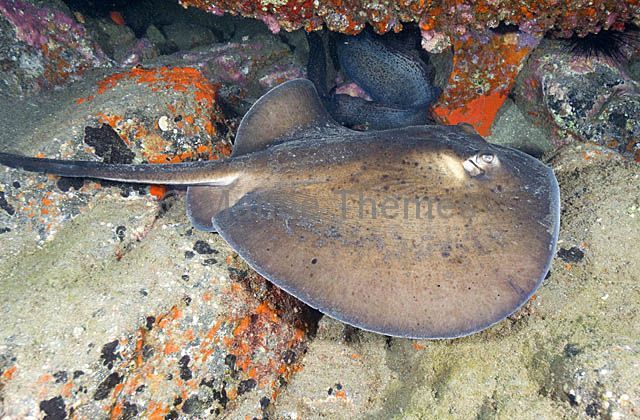 This method has been used many times to treat stingray wounds and the results have been good.
This method has been used many times to treat stingray wounds and the results have been good.
In any case, after first aid, further treatment should be carried out by specialists. Physicians must anesthetize, remove foreign bodies from the wound with minimal tissue damage, determine the use of agents that stimulate respiration and cardiac activity, antibiotics, anti-tetanus vaccinations, sew up lacerated wounds and prescribe further treatment.An x-ray will help determine if there are fragments of thorns in the wound.
Medical insurance. Medical care in other countries is very expensive, so tourists should definitely take out medical insurance. On the site sravni.ru you can compare the cost of health insurance from 12 leading insurance companies and apply for an insurance policy online. Compare.ru – comparison of travel insurance
Stories of victims and eyewitnesses
Vladislav Balinsky , diver from Odessa (was attacked by a stingray on the Odessa beach, July 25, 2016.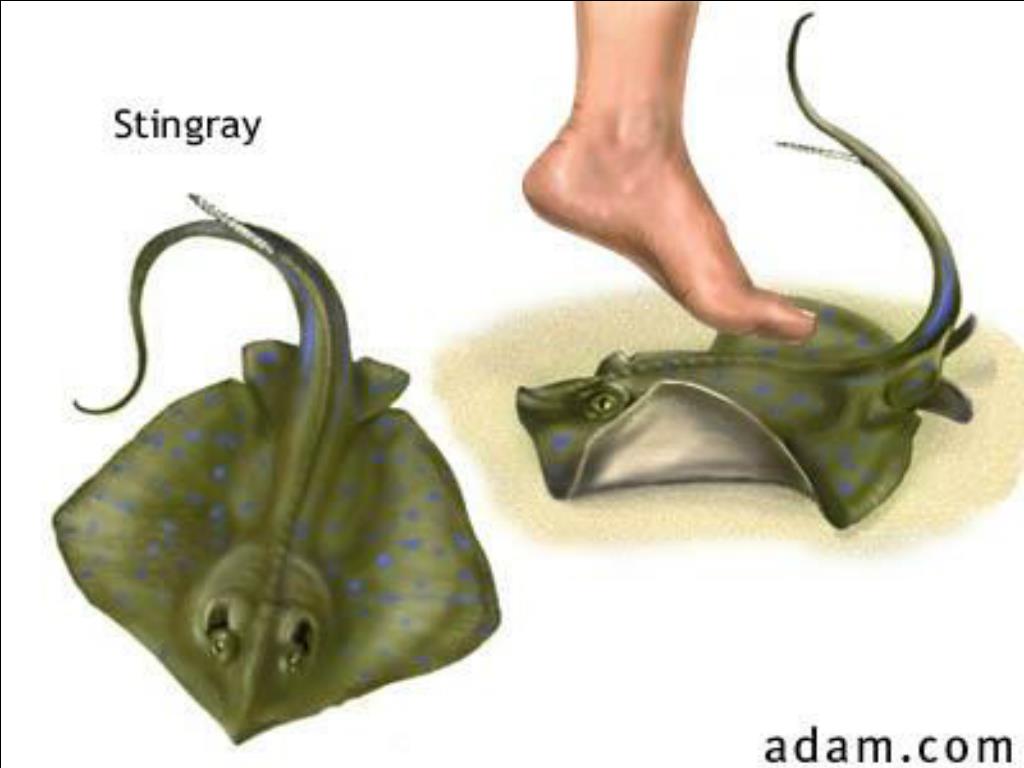 ):
):
In twenty years of active diving, I was struck yesterday for the first time with a thorn in my hand by an ordinary stingray-stingray (Sea cat) … That it is very painful and difficult to stop the bleeding, I hope, many people know. But the fact that today this ancient fish can be encountered right on the beaches of Odessa will be news for many. In my case, of course, I myself am to blame. Sailing along one of the Odessa beaches, in the water area of the breakwater, I was surprised to find 4 medium-sized stingrays.I played with one of them … The whole problem is that the seals were lying not far from the shore, at a depth of one and a half meters, right within the boundaries of the bathing zone.
(http://culturemeter.od.ua/skat-hvostokol-atakoval-plovca-na-odesskom-pljazhe-21480/)
Alexei , Thailand (hit by a stalker spike, 2010):
I was swimming in the glowing plankton at night on that island, and I was thinking how wonderful life in paradise was when I felt that someone was chopping my leg with a chainsaw.Somehow I got to the shore. The pain in my leg is just cosmic, and I decided that I would not cross the mountain .. I did not know what hit me, and how strong the poison was – so I called a friend and he sent a whole destroyer fishing ship for me. Thais heroically and for a very long time maneuvered, coming as close as possible; in the end I lost my patience (hellish pain), squeezed cellophane with a coin in my teeth and scratched it by swimming. It was truly a sprint swim 🙂
The brave sailors took me to the hospital.There the wound was washed, the antidote was rolled in, filled with a bag of pills (ibuprofen, CPM ?, dicloxo … something there and paracetamol) and let go to sleep. I fit into a city hotel, took off my wet clothes, and, to keep my head busy, turned on the TV. On the only English-language channel there was a film about a man-eating shark.
Now I am lying on the veranda of a house in the jungle, with my foot up, for it is swollen like a ball and is gradually turning black. The wound itself, in general, is not scary, so I hope to get back on my feet soon.
(http://zvzz.livejournal.com/419242.html)
Take care of yourself.
For other dangerous fish that you can meet on vacation by the sea, read the article: “Underwater Dangers of the Seas.”
Hotels in Sharm El Sheikh
Booking.com
Safetravels.info
The diver told why stingrays attack in Odessa and what to do when meeting – PHOTO
Stingrays in Odessa occupied the coast and often sting people.Paramedics at Coastal Health Points report 048 of increased incidence of stingray attacks on beachgoers.
Our journalist talked to the diver and biologist Vladislav Balinsky about what kind of creatures they are, how aggressive they are and what to do if you meet a stingray while swimming.
What kind of animal is this?
There are two types of stingrays in the Black Sea – the sea fox and the sea cat (stingray stingray). Those stingrays, which we are talking about in the water area of the Odessa Gulf, are a sea cat.Previously, it was recorded much less often, since it is a deep-sea fish.
Odessa beaches are limited by traverses and breakwaters, and, as a rule, the slopes did not swim over these obstacles. Recently, I personally see them quite often, the first time was about three years ago. Why do stingrays appear on beaches? This is due to global changes, changes in the ecology of the Black Sea. In the Black Sea, the number of zooplankton and, accordingly, fish increases significantly, especially in the northwestern part.Therefore, predators such as stingrays began to be recorded more often on the coast.
As for Odessa, I observed a group of stingrays for a long time in the area of the “Dog” beach on the left side of Dolphin. Since I actively “communicate” with animals, I was also stung by a stingray in my hand. Although most often the injection is in the leg.
How does he react to a person and what happens during an attack?
These fish are very calm. The danger is if they are in shallow water, and a person can simply step on without seeing him in troubled water.Stingrays are able to change color and adapt to the surrounding background, so they are not always noticeable in the water.
This fish can reach large sizes, and specimens of 15 kilograms are found in the Black Sea. Stingrays, along with sharks, are one of the oldest cartilaginous fish, it is dangerous precisely because of the thorn at the end of the tail.
In a calm state, this spike is in the fold of the tail, in case of danger it becomes perpendicular to the tail and the stingray can, with its tail with a spike, make such whip-like blows, quite strong and well-aimed.The spike is double-edged on both sides, and has notches on it.
After the blow, a lacerated wound remains on the body, sometimes the thorn breaks off inside the body. The main problem is that there is also a groove in the spine filled with mucus, which contains a fairly strong poison. This substance is of a protein nature and causes a strong pain reaction.
READ ALSO Children have been vomiting since Tuesday, but they said to be silent: how they concealed the infection in the Odessa kindergarten
Where can you find him?
Particularly dangerous areas of the coast are shallow areas where a person can walk along the bottom for a long time.The most likely time to meet a stingray on Odessa beaches is early morning or evening. I would recommend a person who enters the water on a deserted beach to try to make noise, clap, and make sounds while walking. And it is advisable to swim as soon as possible, not to delay walking along the coastline, and then a meeting with a stingray is impossible, because a stingray is a bottom animal. Only if a person steps on it is a blow possible.
What if a stingray stung?
If possible, it is necessary to suck or try to squeeze out this poison.And hot water helps, of such a temperature that it was hard to endure, pouring it over the injection site. The poison is of a protein nature, at high temperatures it is denatured, and it is deactivated. It is necessary to take pain relievers and antihistamines. And call an ambulance.
Although from my own experience I can say that hot water helps quite well, but it all depends on the size of the injury and individual tolerance. Antihistamines are essential to avoid anaphylactic shock.
In Odessa fish markets, stingrays are often sold. Is it allowed to catch them?
Those stingrays that I saw, they are small, 200-250 grams, this animal is not a rare or endangered species, recently it has been actively used for food. The nutritional value of this fish is not great, but, nevertheless, fishermen catch it. As a rule, a stingray is caught in a nets with a flounder. This fish is not bad for fish soup. She has a slippery skin surface covered with a lot of mucus. This mucus, when cooked, gives the broth and density of the fish soup.Someone is frying stingrays.
READ ALSO NATO ships in Odessa and a cruise ship at the seaport
Stingray sea devil. What to do if bitten by a stingray
Stingrays are the closest relatives of sharks – both of these superorders of fish belong to the class of cartilaginous subclass of the plate-gill.
What they have in common with sharks is that their skeleton does not consist of bones, but entirely of cartilage.
In ancient times, the fish of these two superorders had much more external similarity, but evolution and time changed the rays, adapting them to bottom existence, giving the body a flat shape and changing the shape of the fins and some other organs.But the main feature that unites sharks and rays – the cartilaginous skeleton remained unchanged.
In addition to their distinctive flat appearance, stingrays are characterized by the fact that their gill slits are located on the ventral side of the body. Some species can be distinguished from other cartilaginous species almost exclusively on this basis. The eyeball of the rays from above is accreted to the orbit. The blinking membrane is always absent. There is no anal fin. The teeth of the rays are awl-shaped or are plates, often rounded.
None of them have the sharp, blade-like teeth that many sharks have.
The suborder of stingrays (Batoidea) includes 4 orders (eagle, gnus, stingray and sawfish), which unite about 350 different species of these peculiar fishes. The main external signs of stingrays are known to everyone.
Stingrays are fish with a flat body and pectoral fins fused with the head. The fins of stingrays are commonly referred to as wings. When a ray floats in a layer of water, it. indeed, it is somewhat reminiscent of an eagle soaring in the sky.When moving in water, stingrays of most species do not use the tail fin, which is usually absent, but the wings as a propeller.
The eyes of the stingrays are located above. Above, just behind the eyes, are the spjaculate – the respiratory openings of the gills, necessary for the breathing of the stingray buried in the sand.
The mouth is located underneath, and the rays never see what they are eating. With two nostrils, they smell their prey.
In addition, rays, like other cartilaginous fish, possess sensors that are sensitive to electric fields.These electroreceptors make it possible to locate the victim and identify him by specific electric fields for each species. If the stingray finds prey, then even the strong armor of the shell will not stop it. The teeth of stingrays are thick plates capable of revealing even the strong defenses of the molluscs.
In stingrays, as in all cartilaginous fish, internal fertilization. They belong to ovoviviparous fish. The copulatory organ of males is a pair of pterygopodia, each of which is a modified posterior part of the pelvic fin.
Many stingrays mate in winter. During mating, the male is on top of the female, almost closely following her and, grasping the edge of her thoracic disc with his teeth, introduces one of the pterygopodia into the cloaca of the female.
The fertility of stingrays is not high, therefore, fertilized eggs develop in the womb and, in addition to feeding on the egg yolk, they also receive a nutritious liquid, something like milk. This fluid is secreted by special outgrowths located on the walls of the uterus. Such outgrowths penetrate the embryo’s squirt, and the nutrient fluid enters the digestive tract.Newborn babies remain in the mother’s body until they turn into little stingrays. Immediately after they leave the womb, young stingrays sink to the bottom, looking for food for themselves – worms, crayfish, shrimps.
Stingrays are very widespread in all seas and oceans.
They are found both in the cold waters of the Arctic and Antarctic and in the coastal waters of tropical and subtropical seas. The deep range of stingrays also varies greatly.Many stingrays live near the coast in shallow water, but species are also known that live at a depth of 3000 m or more.
Stingrays are marine fish, but several species are known that can live in fresh water.
In the waters of the seas washing the Russian coast, there are also a variety of stingrays. Our most famous stingray is a stingray called “sea cat”. This stingray is found in the seas of the Far East, in the northern Russian seas, as well as in the Black Sea. The harmless stingray “sea fox” is also well known.
Different orders of stingrays have their own distinctive features.
For example, eagle rays (Myliobatidae) – have pectoral fins that taper or break in front at eye level, so that the head stands out clearly in front of the disc. At the same time, the anterior projections of the pectoral fins are connected to each other under the apex of the snout of the clivus.
Torpediniformes combine electric rays. Representatives of this order usually have an almost round body, thicker and fleshy than that of other stingrays.The narrow caudal part is rather sharply separated from the body; there is a caudal fin. Electric rays are capable of generating electrical energy, using it as a weapon of attack or defense.
Representatives of the order are skate-shaped (or ordinary or rhombo-white rays) (Rajiformes) are characterized by a strongly flattened rhomboid body, the presence of peculiar outgrowths on the pelvic cartilage and traces of gill folds in the spiracles. The body of common stingrays is usually covered with large spines and numerous small spines.Powerfully developed pectoral fins of these rays merge with the sides of the body, resembling wings. The two dorsal fins, on the other hand, are very small and located at the tip of the tail, while the caudal fin itself is in its infancy or is completely absent. Tail spines are absent in rhomboids.
The order sawtooth rays or sawfish (Pristidae) includes only one genus, containing 7 species. They differ from other rays by a strongly elongated snout, which has the shape of an elongated flat blade, set on the sides by large tooth-like outgrowths.
The sizes of different types of rays can vary greatly – from a few centimeters to several meters in wingspan.
The largest representative of the stingray superorder is the manta ray (the second name is “sea devil”), which reaches up to 7 meters in wingspan and more than two tons in weight.
“Sea Devil” is a rather harmless creature, despite the largest of all stingrays in size and a formidable name. This stingray is not endowed with any electrical power, it does not have thorns and terrible teeth.”Sea Devil” has a rather good-natured character, does not touch divers and swimmers. Manta rays or “sea devils” are found in all tropical oceans. They can be seen both on the surface of the water and in its thickness, and when they make their famous jumps, then over the water.
It should be noted that the meat of these rays has been highly valued for its nutritional value and taste since ancient times. However, hunting for this large fish is a rather dangerous activity – despite its good-natured disposition, the manta ray, due to its enormous size, may well sink the fragile boat of fishermen.
The order of eagle rays includes a large family of stingrays. Some zoologists even distinguish this family into a separate order. I don’t think that this is so important for you and me, so I will stick to the classification accepted by most scientists.
A distinctive feature of stingrays of this family is the presence of a bony outgrowth in their tail – a thorn, which is used by stingrayers as a defensive weapon. Usually these spines are connected with special glands that produce a poisonous substance.
Therefore, stingrays can be classified as animals that pose a certain danger to swimmers and divers in the water.
There are many known cases of injuries to people by stingray spikes. And although deaths are extremely rare, you must keep your ear to them. By itself, the stingray does not belong to animals that are aggressive towards humans, it uses its weapons, as a rule, in case of danger, for example, if you step on it through negligence. But the consequences of hitting such a slope with a tail can be the most severe.
A lacerated wound remains at the site of the impact – the spike of the stalker is jagged, and when he pulls it out of the wound, the tissues of the victim’s body are torn.
Here is one of the sad examples of the death of a person from being hit by a stingray-stingray with a thorn.
In the fall of 2006, a popular Australian naturalist, television journalist and author of numerous wildlife films, Steve Irwin scuba dived to photograph the great stingrays off the Great Barrier Reef.
He was collecting material for his next film “Deadly Ocean Creatures”.The presenter has already plunged to the slopes many times. He knew that these fish are rarely truly dangerous to humans – off the coast of Australia there were only two cases of death of tourists injured by stingray spines.
But apparently Steve teased his death too often. One of the fish attacked the leader when he was above her. The stingray lifted its tail and struck a poisonous spike in Steve’s chest, hitting him right in the heart.
The cameraman who followed Steve Irwin videotaped his death.She was later transferred to Steve’s wife, Terry, who decided to destroy her.
The skin of the stalkers is smooth, almost velvety to the touch. The back is dark. Brownish or gray, sometimes dirty tones. Often the back of the stingray is covered with spots, stripes or rings. The belly is light. The rest of the features, except for the tail armed with a spike, are similar to the external features of the representatives of the superorder.
Certain troubles can be caused by the electric stingrays of the squad of gnuslike, which strike their prey, generated in the body, with electrical energy.Electricity is generated by a special organ – a generator and can be used by a ramp as a weapon at any time.
Electric rays, with the help of their current generator organs, can produce discharges of up to 300 volts at a current of 7-8 A (Atlantic torpedo ramp (Torpedo marmorata), but usually much less – 5-40 volts.
This voltage is quite enough to paralyze the victim for a long time and have time to eat it, since electric rays feed on medium-sized marine organisms.
A person can get quite unpleasant sensations from the electrical impulse generated by large stingrays, but they do not pose a particular threat to life.
Interestingly, it was previously considered useful to receive shocks of electric stingrays for the treatment of certain diseases, and people suffering from ailments wandered barefoot in the shallow waters of sandy beaches, hoping to receive a healing blow …
However, for a diver immersed in water with their head, the consequences of electric shock can be much more noticeable than for a person wandering in water up to their knees.
In fairness, it should be noted that electric stingrays never show unreasonable aggressiveness towards people, using their weapons only in case of emergency and danger.
The main thing is not to step on his back.
Other stingray species do not pose any serious threat to the health of divers.
Many predatory fish, especially sharks, are enemies of stingrays, because they love to feast on their tender meat. The predators are also not stopped by the presence of poisonous thorns in stingrays – often in the stomachs of, for example, tiger and hammerhead sharks, many “battle swords” of these fish are found.The stingrays’ spines do not appear to cause significant disturbance to sharks.
In many countries (especially Southeast Asia) stingrays are objects of specialized fishing and are consumed as food. The cuisine of these regions of the planet is rich in exotic dishes. Many gourmets find stingray meat extremely tasty, nutritious and healthy.
The liver of stingrays, rich in vitamin “A”, is a raw material for the production of technical fat and the production of various medical preparations.
Sometimes we even come across information about the miraculous properties of this liver in the treatment of some intractable human ailments.
The skin of stingrays, like the skin of sharks, has unique strength properties, and is also used in some areas of human activity.
Since rays rarely form dense accumulations, experts consider bottom longlines to be the most effective fishing tool.
Stingrays are also hunted by lovers of underwater hunting.
Are stingrays dangerous and how to behave
when meeting a stingray under water?
Stingrays are the closest relatives of sharks – both of these superorders of fish belong to the class of cartilaginous subclass of lamellar gills.
What they have in common with sharks is that their skeleton does not consist of bones, but entirely of cartilage.
In ancient times, there were much more external similarities between the fishes of these two superorders, but evolution and time changed the rays, adapting them to bottom existence, giving the body a flat shape and changing the shape of the fins and some other organs. But the main feature that unites sharks and rays – the cartilaginous skeleton remained unchanged.
In addition to their distinctive flat appearance, stingrays are characterized by the fact that their gill slits are located on the ventral side of the body.Some species can be distinguished from other cartilaginous species almost exclusively on this basis. The eyeball of the rays from above is accreted to the orbit. The blinking membrane is always absent. There is no anal fin. The teeth of the rays are awl-shaped or are plates, often rounded.
None of them have the sharp, blade-like teeth that many sharks have.
The suborder of stingrays (Batoidea) includes 4 orders (eagle, gnus, stingray and sawfish), which unite about 350 different species of these peculiar fishes.The main external signs of stingrays are known to everyone.
Stingrays are fish with a flat body and pectoral fins fused with the head. The fins of stingrays are commonly referred to as wings. When a ray floats in a layer of water, it. indeed, it is somewhat reminiscent of an eagle soaring in the sky. When moving in water, stingrays of most species do not use the tail fin, which is usually absent, but the wings as a propeller.
The eyes of the stingrays are located above. Above, just behind the eyes, are the spjaculate – the respiratory openings of the gills, necessary for the breathing of the stingray buried in the sand.
The mouth is located underneath, and the rays never see what they are eating. With two nostrils, they smell their prey.
In addition, rays, like other cartilaginous fish, possess sensors that are sensitive to electric fields. These electroreceptors make it possible to locate the victim and identify him by specific electric fields for each species. If the stingray finds prey, then even the strong armor of the shell will not stop it. The teeth of stingrays are thick plates capable of revealing even the strong defenses of the molluscs.
In stingrays, as in all cartilaginous fish, internal fertilization. They belong to ovoviviparous fish. The copulatory organ of males is a pair of pterygopodia, each of which is a modified posterior part of the pelvic fin.
Many stingrays mate during the winter. During mating, the male is on top of the female, almost closely following her and, grasping the edge of her thoracic disc with his teeth, introduces one of the pterygopodia into the cloaca of the female.
The fertility of stingrays is not high, therefore, fertilized eggs develop in the womb and, in addition to feeding on the egg yolk, they also receive a nutritious liquid, something like milk.This fluid is secreted by special outgrowths located on the walls of the uterus. Such outgrowths penetrate the embryo’s squirt, and the nutrient fluid enters the digestive tract. Newborn babies remain in the mother’s body until they turn into little stingrays. Immediately after they leave the womb, young stingrays sink to the bottom, looking for food for themselves – worms, crayfish, shrimps.
Stingrays are very widespread in all seas and oceans.
They are found both in the cold waters of the Arctic and Antarctic and in the coastal waters of tropical and subtropical seas.The deep range of stingrays also varies greatly. Many stingrays live near the coast in shallow water, but species are also known that live at a depth of 3000 m or more.
Stingrays are marine fish, but several species are known that can live in fresh water.
In the waters of the seas washing the Russian coast, there are also a variety of stingrays. Our most famous stingray is a stingray called “sea cat”. This stingray is found in the seas of the Far East, in the northern Russian seas, as well as in the Black Sea.The harmless stingray “sea fox” is also well known.
Different orders of stingrays have their own distinctive features.
For example, eagle rays (Myliobatidae) – have pectoral fins that taper or break in front at eye level, so that the head stands out clearly in front of the disc. At the same time, the anterior projections of the pectoral fins are connected to each other under the apex of the snout of the clivus.
Torpediniformes combine electric rays.Representatives of this order usually have an almost round body, thicker and fleshy than that of other stingrays. The narrow caudal part is rather sharply separated from the body; there is a caudal fin. Electric rays are capable of generating electrical energy, using it as a weapon of attack or defense.
Representatives of the order are skate-shaped (or ordinary or rhombo-white rays) (Rajiformes) are characterized by a strongly flattened rhomboid body, the presence of peculiar outgrowths on the pelvic cartilage and traces of gill folds in the spiracles.The body of common stingrays is usually covered with large spines and numerous small spines. Powerfully developed pectoral fins of these rays merge with the sides of the body, resembling wings. The two dorsal fins, on the other hand, are very small and located at the tip of the tail, while the caudal fin itself is in its infancy or is completely absent. Tail spines are absent in rhomboids.
The order sawtooth rays or sawfish (Pristidae) includes only one genus, containing 7 species. They differ from other rays by a strongly elongated snout, which has the shape of an elongated flat blade, set on the sides by large tooth-like outgrowths.
The sizes of different types of rays can vary greatly – from a few centimeters to several meters in wingspan.
The largest representative of the stingray superorder is the manta ray (the second name is “sea devil”), which reaches up to 7 meters in wingspan and more than two tons in weight.
“Sea Devil” is a rather harmless creature, despite the largest of all stingrays in size and a formidable name. This stingray is not endowed with any electrical power, it does not have thorns and terrible teeth.”Sea Devil” has a rather good-natured character, does not touch divers and swimmers. Manta rays or “sea devils” are found in all tropical oceans. They can be seen both on the surface of the water and in its thickness, and when they make their famous jumps, then over the water.
It should be noted that the meat of these rays has been highly valued for its nutritional value and taste since ancient times. However, hunting for this large fish is a rather dangerous activity – despite its good-natured disposition, the manta ray, due to its enormous size, may well sink the fragile boat of fishermen.
The order of eagle rays includes a large family of stingrays. Some zoologists even distinguish this family into a separate order. I don’t think that this is so important for you and me, so I will stick to the classification accepted by most scientists.
A distinctive feature of stingrays of this family is the presence of a bone outgrowth in their tail – a thorn, which is used by stingrayers as a defensive weapon. Usually these spines are connected with special glands that produce a poisonous substance.
Therefore, stingrays can be classified as animals that pose a certain danger to swimmers and divers in the water.
There are many known cases of injuries to people by stingray spikes. And although deaths are extremely rare, you must keep your ear to them. By itself, the stingray does not belong to animals that are aggressive towards humans, it uses its weapons, as a rule, in case of danger, for example, if you step on it through negligence. But the consequences of hitting such a slope with a tail can be the most severe.
A lacerated wound remains at the site of the impact – the spike of the stalker is jagged, and when he pulls it out of the wound, the tissues of the victim’s body are torn.
Here is one of the sad examples of the death of a person from being hit by a stingray-stingray with a thorn.
In the fall of 2006, a popular Australian naturalist, television journalist and author of numerous wildlife films, Steve Irwin scuba dived to photograph the great stingrays off the Great Barrier Reef.
He was collecting material for his next film “Deadly Ocean Creatures”.The presenter has already plunged to the slopes many times. He knew that these fish are rarely truly dangerous to humans – off the coast of Australia there were only two cases of death of tourists injured by stingray spines.
But apparently Steve teased his death too often. One of the fish attacked the leader when he was above her. The stingray lifted its tail and struck a poisonous spike in Steve’s chest, hitting him right in the heart.
The cameraman who followed Steve Irwin videotaped his death.She was later transferred to Steve’s wife, Terry, who decided to destroy her.
The skin of the stalkers is smooth, almost velvety to the touch. The back is dark. Brownish or gray, sometimes dirty tones. Often the back of the stingray is covered with spots, stripes or rings. The belly is light. The rest of the features, except for the tail armed with a spike, are similar to the external features of the representatives of the superorder.
Certain troubles can be caused by the electric stingrays of the squad of gnuslike, which strike their prey, generated in the body, with electrical energy.Electricity is generated by a special organ – a generator and can be used by a ramp as a weapon at any time.
Electric rays, with the help of their current generator organs, can produce discharges of up to 300 volts at a current of 7-8 A (Atlantic torpedo ramp (Torpedo marmorata), but usually much less – 5-40 volts.
This voltage is quite enough , in order to paralyze the victim for a long time and have time to eat it, since electric rays feed on medium-sized marine organisms.
A person can get quite unpleasant sensations from the electrical impulse generated by large stingrays, but they do not pose a particular threat to life.
Interestingly, it was previously considered useful to receive shocks of electric stingrays for the treatment of certain diseases, and people suffering from ailments wandered barefoot in the shallow water of sandy beaches, hoping to receive a healing blow …
However, for a diver immersed in water with his head, the consequences of injury electric shock can be much more noticeable than for a person wandering knee-deep in water.
In fairness, it should be noted that electric stingrays never show unreasonable aggressiveness towards people, using their weapons only in case of emergency and danger.
The main thing is not to step on his back.
Other stingray species do not pose any serious threat to the health of divers.
Many predatory fish, especially sharks, are enemies of stingrays, because they love to feast on their tender meat. The predators are also not stopped by the presence of poisonous thorns in stingrays – often in the stomachs of, for example, tiger and hammerhead sharks, many “battle swords” of these fish are found.The stingrays’ spines do not appear to cause significant disturbance to sharks.
In many countries (especially Southeast Asia) stingrays are objects of specialized fishing and are consumed as food. The cuisine of these regions of the planet is rich in exotic dishes. Many gourmets find stingray meat extremely tasty, nutritious and healthy.
The liver of stingrays, rich in vitamin “A”, is a raw material for the production of technical fat and the production of various medical preparations.
Sometimes we even come across information about the miraculous properties of this liver in the treatment of some intractable human ailments.
The skin of stingrays, like the skin of sharks, has unique strength properties, and is also used in some areas of human activity.
Since rays rarely form dense accumulations, experts consider bottom longlines to be the most effective fishing tool.
Stingrays are also hunted by lovers of underwater hunting.
When diving in places where stingrays are found, do not forget the first rule of safe communication with representatives of the marine fauna, which is set out
Biting fish
Sharks
The most famous of the dangerous fish are sharks.
Of the more than 450 existing shark species, only a few are truly dangerous. The greatest danger is posed by such species as white shark, blunt shark, tiger shark, mako shark, long-winged shark.
Considered [ by whom?
]
that in most cases of attacks the shark was somehow provoked by a person: noisy games in the water, floundering of an inept swimmer, sudden panic movements, blood getting into the water. The great white shark attacks surfers, mistaking the shadow of the surf for the shadow of the sea lion, its favorite prey.However, unmotivated attacks on people are also known.
It should be remembered: any shark longer than 80 cm can cause life-threatening injuries to a person, so representatives of this family should not be teased or otherwise provoked. Cases are known [ what?
]
when sharks, usually harmless species, inflicted serious injuries on people who decided to tease them.
Barracuda
Piranha
Of the 30 species of piranhas that are found in the rivers of South America, about 5 species are dangerous, and the most dangerous are two species – the common piranha and the large piranha.They pose a danger to humans due to the fact that they are group hunting for prey and can attack any object in the water. A large number of fish in a school, high speed of movement and sharp teeth lead to the fact that piranhas literally tear the prey into small pieces and eat, leaving only large bones. However, many piranha species are suitable for keeping in aquariums.
Tiger fish
Bottom fish
Dangerous bottom fish should include the inhabitants of the bottom layer, which, defending themselves, can inflict wounds and injuries on a person.In particular, this group should include the stingray and the monkfish.
Monkfish
Monkfish is a bottom fish, up to 170 cm long, living both at depths of up to 600-800 meters, and in the littoral (coastal) zone. Representatives of the species spend most of their time partially buried in sand or among stones. A person who steps on a monkfish or comes close to it can get a strong bite.
Stingray stingray usually refers to those species of the stingray family that have sharp, hard spikes on their tail and use it as a means of hunting or self-defense.Stingrays spend a lot of time buried in the sand near the coast, so in their habitats you should be careful not to step on one of them. The best anti-stingray remedy is to walk in shallow water, dragging your feet. If the foot does not step, but stumbles upon a stingray, it will simply float away.
The largest member of the group is the sea cat (Dasyatis pastinaca), reaching a size of 2.5 m. A blow from its tail can cause serious injury. In addition, it must be remembered that many of the stingrays can be poisonous, and severe poisoning can be added to the wound from the blow (the severity depends on the type of stingray and the place of impact).
Representatives of the chimera family can reach lengths of up to 1.5 m and have a large spine-like process on the body near the head. Despite the fact that they live mainly at depths, juveniles in the summer season can swim into the coastal strip and be dangerous for an unwary diver.
Fish injuring thorns or thorns
Scorpion
The Scorpion-like squad, in which almost all species (about 350) are armed with thorns.And such as the 40-centimeter scorpion, which gave the name to the family, is dangerous and poisonous thorns. A person who steps on a scorpion can be seriously injured, and according to some reports, even fatal.
Wart
is a carnivorous fish of the wart family with poisonous spines on its back, which lives on the bottom near coral reefs and camouflages itself under a stone. It is considered the most poisonous fish in the world.
Toad fish
Toad, or toad fish, covered with outgrowths, has no scales, but many thorns.
Zebra Fish
Zebra fish or lionfish, a bright coral fish, can cause severe injury with spines at the end of which are poison.
Chimeras: most have spiny spines on their dorsal fins.
The gray triggerfish has a large and strongly piercing spine on its back, near the fin.
The wart has strongly stabbing spines on its back that are poisonous. At the slightest irritation, the wart raises the spines of the dorsal fin; sharp and durable, they easily pierce the shoes of a person who accidentally stepped on a fish, and penetrate deep into the leg.With deep penetration, the injection can be fatal to a person if he does not receive medical attention for several hours. If the poison gets inside, depending on the depth of penetration, a strong tightening bandage or a hemostatic tourniquet is applied, which is placed between the wound and the nearest bend. If a thorn gets into a large blood vessel, death can occur in 2-3 hours. Survivors sometimes get sick for months.
Fish-surgeons: on its tail there are two spines resembling scalpels (hence the name) and inflicting severe injuries on predators or careless people.
Stingrays there are approximately 30 species. Common off the coast of Australia. Some stingray species live in the Amazon and its tributaries. Stingrays are also found in the Black Sea (common sea cat). At the base of the tail of these fish there is a thorn or several thorns connected by ducts with a poisonous gland. Handling the caught stingray, as with all stingrays, requires great care, since the prick of its poisonous tail needle is extremely painful and can cause severe discomfort.Sea cats are also dangerous for swimming people, who sometimes step on a stingray, which is almost invisible at the bottom. They can inflict serious and sometimes fatal injuries with a strong blow from a tail armed with a spike.
In particular, the famous Australian TV presenter and wildlife researcher Steve Irwin died during an underwater filming from the impact of a stingray. Irwin worked on a documentary film about the life of the inhabitants of the seabed in the Great Barrier Reef off the coast of Australia, near the city of Port Douglas.He died when a Ridge-tail stingray struck him in the chest, with his spike he pierced the wetsuit and inflicted a wound in the region of the heart. A helicopter with doctors immediately arrived at the scene, but it was no longer possible to save Irwin.
Some sea catfish can injure humans with spikes on their fins. The most common of them are eel catfish, pennant catfish, galeicht catfish, and clary catfish. And in some species, thorns are poisonous. In the freshwater catfish Pimelodella, found in the Orinoco River, the pectoral fins are lined with spines covered with poisonous mucus.
Great Sea Dragon
Parrot fish and whitefish, or motley fish, sea dragon are also dangerous. The thorns of the sea dragon, located on the fins and gills, are equipped with venomous glands; a prick with these thorns is very painful for humans. The sea dragon is the most dangerous poisonous fish in Europe; there are known cases of death of people after they were wounded by sea dragons. Special care should be taken by anglers: a dragon caught on a hook can be confused with a goby.
The Stargazer family has 35 species and lives mainly in the warm and temperate zones of the Atlantic, Indian and Pacific oceans; 1 species in the Black Sea – stargazer fish. He, like most of the species from his family, has poisonous spines above the pectoral fins and behind the gill covers, they pose a danger to bathers. On a muddy or sandy bottom, it can be practically invisible, the fish can sometimes burrow into it up to the eyes.
Shark scales
Sharks covered with thorny placoid scales.Carelessly touching the body of some species of sharks, you can skin your body to the bone. The spiky shark has the sharpest scales, for which it is sometimes called the “blackberry shark”. In this respect, sharks of the squadron-like sharks are also dangerous, (one of the species – the butt, or ordinary katran – is found in the Black Sea), straight-mouthed katran, polar shark, star-spiked and triangular sharks, luminous shark and pig shark. Most of the katraniformes have spiny thorns on their dorsal fins, with which they can cause serious injuries to unwary bathers.
Fish inflicting electrical injuries
Electric ramp
Electric fish have the ability to generate electrical discharges with the help of special electrical organs. However, only the so-called highly electric fish pose a danger to humans, including:
- Electric ramp. Electric rays are the most dangerous electric fish. Found in the coastal waters of the Atlantic and Indian Oceans.The voltage of the electric charge in the fish is from 8 to 220 V (with a current of 60 A). The electrical organs are on the back of the fish. After a blow, in addition to terrible pain, a person has to experience not the most pleasant sensations – his body is trembling.
- Electric eel, impact voltage – about 600 V, fish poses a considerable danger to the inhabitants of South America, where it lives.
- Electric Catfish: Found in Africa. Current pulses generated by the organs of electric catfish, according to some sources, can reach 360 V.There are known cases of electric shock when a person stepped on a catfish with his bare foot.
Fish causing foodborne illness
Spinhorn possesses poisonous meat.
Tetrodons, or blowfish. In Japan, this fish is known as fugu – after special preparation it can be eaten, which is still deadly risky. (In any case, the fish from which the dish is prepared contains a lethal dose of tetrodotoxin, the concentration of which must be reduced to an acceptable level during the cooking process.)
Dogfish: Dog meat is poisonous.
Fish-hedgehogs: poisonous, in case of danger they swell the body covered with thorns.
Luna fish: the liver and milk of this fish cause vomiting, nausea, and suffocation. In severe cases, death from pulmonary paralysis occurs.
Crimean barbel or madder. Eating caviar in food can lead to severe poisoning.
Barracuda meat, especially their caviar, milk and liver, can cause paralysis in humans.
Among the dangerous inhabitants of tropical seas, stingrays with poisonous sharp needles on a long tail, called stingrays, are well known.This is a separate order in the class of cartilaginous fish and it is called the Tailfish (scientific name Dasyatiformes). It consists of seven families, most of which have one or two sharp dagger-like needles on their long tail. Stingray – stingray is dangerous with double weapons: the aforementioned needles and poisonous glands located in the needles. Almost all tails live in the sea,
but there is also (a family of river stingrays).
Family Stingray or true stingray
In the stingray family, often called true stingrays – stingrays (scientific name Dasyatidae), absolutely all representatives have a set of deadly weapons: poison glands and dagger-like needles.In other families of the Tailfish order, not everyone has such a weapon.
Most stingrays live in warm seas, preferring shallow water areas. And few are inhabitants of temperate waters, such as the red stingray found in the Sea of Japan. There are species that enter rivers, and some remain to live there.
Stingray fish of the Dasyatidae family are usually found at the bottom (with sandy or muddy bottom). It is so buried in the ground that it is difficult to see it from the outside.If necessary, she can swim, swinging her pectoral fins, developing a good speed. Few stingrays of this family are pelagic (living far from the coasts).
Features of appearance and dangerous spikes
In appearance, stingrays are very different from all other fish. Their body looks like a pancake, it is almost completely flat, flattened from top to bottom. Scientifically speaking, the body of rays is compressed in the dorso-ventral direction and has the shape of a disc.The body shape of real stingrays resembles either an elongated rhombus or a wide oval, sometimes up to 2 meters wide. It is interesting that the width of the disc-shaped body is almost a third longer than the length.
The peculiarity of the location of the fins of the stingrays – stingrays:
- The large pectoral fins in all rays are a continuation of the flat body, surrounding it from all sides in the form of a thin border, and in some species connecting to each other. For example, in stingrays, both pectoral fins fuse with the head and in front of the head merge together into a single whole.
- Unpaired fins (caudal, dorsal and anal) are absent in members of the Dasyatidae family (in other species of rays, for example, two dorsal and caudal fins are well developed).
- Two anal fins are clearly visible and displaced, as in all rays
, to the very tail.
The peculiarity of the appearance of true stingrays (Dasyatidae) is a thin and long tail (with the exception of a few species), bearing 1 or 2 poisonous spines (thorns). The skin is smooth, pleasantly velvety, without numerous spines.
Ringed Stingray Stingray
Dagger needles and poison
The name stingrays was given to this group of rays due to the presence of sharp spines on the upper surface of their tail, which are sometimes called needles. The end of such a spike is very sharp, and the surface is roughly serrated on both sides. The thorn has a flat shape (compressed from the sides) and can reach a length of more than 30 centimeters in the largest fish.
The spike is attached directly to the skin of the stingray approximately in the middle of the tail and lies so that the point is directed backward.
On the underside of the thorn there is a groove-shaped depression, the bottom of which contains cells of poisonous glands, from which poison is secreted. Outside, the thorn is covered by a kind of shell in the form of a thin layer of skin, and secreted poison accumulates in this shell.
How Stingray Stingray Uses a Poison Needle
The stingray fish uses its formidable poisonous weapon solely for defense purposes. The tail spine is motionlessly located on the tail, and when the stingray bends the tail and acts like a whip, the blows are quite powerful.Large fish are capable of hitting so hard that the spike is easily capable of piercing even leather shoes and deeply entering the body of a person who inadvertently disturbed the stingray in shallow water.
The toxicity of stingray stingrays venom is strong. The injured person has spasms accompanied by pain. There is also a decrease in blood pressure, increased heart rate, often accompanied by vomiting. Muscle paralysis may occur. There have been cases when people died after stinging stingray shots.
Leopard Stingray Stingray
Leopard stingray and its training
The leopard stingray (Himantura undulata) is one of the largest members of the Dasyatidae family.The maximum length of its body, including the tail, reaches 410 centimeters, and the diameter of the body is about 150 centimeters. These fish are born almost 1 meter long (92 centimeters), and the diameter of the newborn’s body is about 20 centimeters. The scourge-shaped tail of this stingray is very long and, as a rule, it has one thorn, but sometimes there can be two thorns.
The leopard stingray got its name due to the original coloring of the dorsal part of the body, very similar to the pattern of a leopard: against a yellowish background, there are rounded brown rings and dark spots.But the abdominal part of the body is very light. The snout is pointed and the pectoral fins have rounded edges.
Himantura undulata leopard stingray can only be kept in aquariums, for keeping in ordinary aquariums, even very large ones, it is not suitable. Under natural conditions, it feeds in the bottom layer of water, where it spends almost all the time. In the aquariums, this stingray is offered a menu of squid meat, fish fillets (for example, char is used in the Primorsky Aquarium in Vladivostok), as well as crustaceans and bivalve molluscs.
Leopard stalkers can be successfully trained. Despite the fact that they are very dangerous, experienced divers-trainers managed to establish a trusting relationship with these unusual fish. Now all visitors of the Primorsky Oceanarium on Russky Island in Vladivostok can watch a show with leopard rays three times a week, which looks like fantastic underwater dances of people and fish.
Human deaths after contact with stingrayers
Experts noted that there are very few cases of aggression from stingrays towards humans, this rarely happens.A stingray fish usually does not attack a person itself and uses its poisonous spike only for defense. However, there are known cases of death as a result of interaction between humans and stingrays. They happened because the fish perceived the actions of the divers near them as hostile and began to defend themselves.
Under these circumstances, the caretaker-diver of the Underwater World aquarium on Sentosa Island, Singapore, died. The diver had the task of preparing the stingray for moving to another aquarium.But the stingray took this situation as a threat to itself and pierced the person with a poisonous thorn, which led to the death of the diver.
Stingray meat is a tasty and healthy food product. It contains high-quality protein containing amino acids, water, ash, fats, a significant amount of vitamin A. The composition contains sodium, magnesium, molybdenum, cobalt, copper, iodine, sulfur, phosphorus, chlorine, vitamin PP. The calorie content of stingray meat is about 110 kcal per 100 grams of pure product.
Stingray is a real delicacy. Culinary experts value wings, that is, fins, and especially the liver. Many people compare stingray liver to – it has the same excellent taste and is rich in vitamin A. Also, the liver is a source of healing fat.
How to cook
Before eating, stingray meat must be thoroughly soaked, this will get rid of the unwanted odor. After that, the meat can be cooked in any way – fry, bake in the oven or grill, boil soups.
In addition to being eaten, they are also used as a source of the most valuable raw material for leatherworking – leather. Stingray leather has an expensive sophisticated look and at the same time has extraordinary durability. It is resistant to the appearance of cuts and scratches, practically does not wear out over time, it does not threaten the appearance of cracks and abrasions. Stingray leather purses and purses can be used forever.
90,000 a danger that you can not suspect
Blue-spotted stingray stingray lives in the Red Sea.He likes to lie on the bottom next to the shore and I myself have repeatedly swam over him. But I never suspected that he could be dangerous.
Meet the stingray
These stingrays belong to the family of cartilaginous fishes of the stingray order. In Latin, it is called Taeniura Lymma. These rays live in all warm seas and oceans. They lead a sedentary lifestyle and during the day they simply lie on the bottom of the sea, sometimes they bury themselves in the sand. Stalkers love to be close to the coast and, in addition to the sea, they also swim into mangroves and even rivers if they flow into the southern seas.
Photo from the site redseafoto.ru
It is easy to meet stingrayers near the beaches of Sharm el-Sheikh or Hurghada. Personally, I have never seen very large stingrays of this species. Ichthyologists claim that their disc sometimes reaches a diameter of 70 cm – no more. The stingrays feed on worms, crayfish, shrimps. They even have teeth that look like a plate. These teeth are so strong that they often even open the shells of molluscs.
Photo from redseafoto.ru
Stingray stingrays are viviparous. Embryos develop in eggs in the womb, and then they are born in a formed form. As soon as they are born, they immediately begin to lead the usual way of life of stingrays: they sink to the bottom and feed on small shrimps, crustaceans, mollusks.
Medical insurance with COVID-19 coverage
This type of ray is sensitive to electric fields. They use this ability to hunt. Using electroreceptors, they locate the victim.
Why was this stingray so named?
The tail of the stingray ends with a sharp, laterally flattened thorn, which can reach a length of 37 cm. The thorn has jagged edges along the edges. Defending, the stingray uses its tail as a whip and strikes the victim, tearing the flesh with a thorn. The force of the blow of the stingray tail is such that it can pierce thick leather shoes or human clothing with a spike. I must say in defense of the stingrays that they never attack themselves, but only defend themselves. Therefore, if you do not touch them or accidentally step on them, they will not harm a person.
Photo from redseafoto.ru
Stingray stingrays are poisonous
Besides the fact that the thorn is a dangerous cold weapon, it also releases poison, which is located in special glands. Once in the victim’s blood, the stingray poison:
- causes severe, spasmodic pains;
- sharply reduces blood pressure, which is manifested by weakness, chills, vomiting, loss of consciousness;
- greatly increases the heart rate;
- Leads to muscle paralysis.
If a person gets hit by a stingray-stingray under water, he will not be able to swim himself, because the symptoms of intoxication develop quickly.And thus, the impact of the stingray can be fatal.
It was from the blow of the stingray that the famous naturalist and TV presenter Steve Irwin died.
Finding tickets for charter and scheduled flights
The poison of even a dead stingray is a serious danger. The North American Indians knew about this property and used the stingray spike itself, containing poison, as a spearhead or arrowhead.
First aid for intoxication with stingray poison
Let’s first find out what categorically CANNOT be done .
So, in case of intoxication with stingray poison DO NOT :
- Try to jerk the thorn out or make an incision to pull it out.
- Do not cauterize the wound with iodine or other alcohol-containing agents.
- Do not take alcohol, as it will increase the blood flow and the poison will spread through the body faster.
- Do not wash the wound with potassium permanganate or other oxidizing agents such as lemon juice.
How can you provide first aid to a victim?
- We need to suck the poison out of the wound.It is especially advisable to do this in the first 10 minutes after the patient has received a thorn. The mouth must be rinsed with clean water or potassium permanganate. Naturally, when aspirated, the poison must be spat out.
- After that, you need to rinse the wound well with water, you can even sea. This will reduce the concentration of the poison.
- Carefully remove the thorn. In this case, you must first submit it forward, and then – scroll.
- A tourniquet must be placed above the wound to slow the spread of the poison through the bloodstream.In this case, the injured limb must be immersed in hot water for 30 minutes. It is also recommended to add 3% magnesium sulfate to the water. REMEMBER that the tourniquet must be loosened and then tightened again every 10 minutes to avoid pinching the vessels.
- After that, it is necessary to apply an antiseptic bandage and immobilize the limb.
Video with a stingray in the Red Sea:
A terrible wound in the Black Sea! A man suffered from a stingray in Evpatoria
In Evpatoria, tourists were wounded by an inhabitant of the Black Sea.Reported by KP-Crimea.
The couple were vacationing at sea. They tell how a stingray was discovered in the water area of the sea.
“We stopped on the shore between the monument to paratroopers and the stele“ Evpatoria – 2500 ”. The children were running aground, and my husband put on a mask and fins and began to dive, ”Anastasia Balina told Komsomolskaya Pravda – Crimea.
So, it was told how the man reacted to the “find”.
“All the bottom there is in the slopes. The first time I see this, they seem to be found only near Kerch, – Alexander shared what he saw under water, took a penknife and dived again.
The victim had to call an ambulance.
“My husband started to have very strong pains, just wild ones, apparently a stingray injected him with some kind of poison into the wound. And I was very scared – although I was born and live in Crimea, but for the first time I faced such a situation and I am very grateful to the doctors. Such good fellows, and the ambulance team and the doctor on duty at the Evpatoria hospital (the emergency happened on July 25. – Author) – everything is fast, clear! They gave injections, pills, calmed and explained. Many human thanks! ”, – the victims shared.
At the moment it is already known how a man feels after a week.
“My husband was sore from pain for another four hours – the doctor warned him that he would be ill for a long time. More than a week has passed since the emergency, but my hand is still aching. It was just that the injection fell near the joint, which is why it probably does not go away for so long, ”said the young woman.
The expert commented on the situation. So, he notes that in the sea “it is better to walk less and swim more.”
“This is a stingray, another name is a sea cat.A poisonous spike on the tail is harmless to humans, but the injection is painful. Stingrays can strike with their tail only if they are disturbed – by stepping on or grabbing them. The sea cat is a bottom fish that uses the spine solely for protection. Therefore, it is better to walk in the sea less, and swim more – if you swim over the slope, it will not touch you, ”- said the associate professor of the Department of Ecology and Zoology of the Faculty of Biology and Chemistry of the Taurida Academy of the KFU. V. I. Vernadsky. Sergei Leonov.
REFERENCE:
Features of appearance and dangerous spikes
In appearance, stingrays are very different from all other fish.Their body looks like a pancake, it is almost completely flat, flattened from top to bottom. Scientifically speaking, the body of rays is compressed in the dorso-ventral direction and has the shape of a disc. The body shape of real stingrays resembles either an elongated rhombus or a wide oval, sometimes up to 2 meters wide. It is interesting that the width of the disc-shaped body is almost a third longer than the length.
The peculiarity of the location of fins in stingrays – stingrays:
- Large pectoral fins in all rays are a continuation of a flat body, surrounding it from all sides in the form of a thin border, and in some species connecting with each other.For example, in stingrays, both pectoral fins fuse with the head and in front of the head merge together into a single whole.
- Unpaired fins (caudal, dorsal and anal) are absent in representatives of the Dasyatidae family (in other species of rays, for example, in electric ones, two dorsal and caudal ones are well developed).
- Two anal fins are clearly visible and displaced, as in all rays, towards the tail itself.
The peculiarity of the appearance of true stingrays (Dasyatidae) is a thin and long tail (except for a few species), bearing 1 or 2 poisonous spines (thorns).The skin is smooth, pleasantly velvety, without numerous spines.
Poisonous fish of the southern seas – rules of conduct and first aid
And finally, all that remains is to pack your bags – and the amazing, mysterious, inviting expanses of the southern seas will open their arms to you …
But so that the vacation is a success and nothing darkens your memories, you need to know what dangers the motley underwater world is fraught with, how to avoid them and what should be done if you still have an accident.
Contents of the article:
Shark
Of all sea nightmares, the first thing that comes to mind is the terrible shark jaws. However, there is no need to be afraid of a sharp fin cutting through the sea surface. Only a few species are considered dangerous to humans.
Most often divers encounter reef shark . It reaches a little more than two meters in length, has its own territory and does not like very much when it is invaded. This shark feeds on fish and crustaceans, it tries to avoid people.
More dangerous is dark gray shark . It also feeds on fish, molluscs and crustaceans, but has a more massive jaw, this shark is very curious and rather aggressive, so you need to be wary of it. If you are vacationing in Egypt , then remember – the most dangerous shark of the Red Sea is white-tip gray shark . It resembles a smaller great white shark, with a massive body and large fins. Its length is up to three meters, and its weight is up to 160 kilograms.
In third place in the list of sharks dangerous to humans – hammerhead shark , which reaches a length of 4 meters and has a full mouth of sharp teeth. In second place is the tiger shark, and the great white shark is the most dangerous and bloodthirsty.
Code of Conduct : The best precaution is to stay away from sharks. Don’t swim in the open sea at night – sharks usually hunt at night. You can’t feed sharks! And if it suddenly happened that you found these predators in dangerous proximity – do not panic, do not hit the water with your feet and hands, do not run away! Face the shark, showing calmness and friendly intentions.If the shark attacks, approaching you in closed circles, then it makes sense to swim with rhythmic strokes towards it. When attacking a shark, you need to hit it with a fist with a foot or a camera directly in the nose, try to grab it by the fin and swim nearby until there is an opportunity for rescue or the shark swims away. There were cases when even great white sharks stopped attacking a person after they received a decisive rebuff from him.
Barracuda
Another underwater predator that is unlikely to be pleasant to meet is the barracuda (ocean pike).These cigar-like fish up to two meters in length prefer to hunt in packs and often accompany sharks. The huge mouth of the barracuda is dotted with large, sharp teeth. In a school, fish feel confident, not shy and can attack a lone scuba diver. However, most cases of attacks on people were recorded in troubled waters. Most likely, they took the swimmer’s arm or leg for a fish.
Rules of Conduct: Do not approach, do not feed, behave calmly! If you are attacked by a barracuda, you need to disinfect the wounds and consult a doctor.
Groupers
Groupers, or sea bass are large enough predators, inhabitants of coral reefs. They are nocturnal, feeding on small fish and crustaceans. Sometimes they reach impressive sizes – more than two meters in length and up to 300 kg in weight. These fish have lived in the same place all their lives. For humans, they are not dangerous if you follow the precautions.
Code of Conduct: Do not get too close, do not touch the fish with your hands, do not try to feed it – it may mistake your hands for its food.
Moray eels
Moray eels are often found in coral reefs, and thanks to their long serpentine body, which can reach a length of 3 meters, and their mouths studded with numerous needle-shaped teeth, they inspire a natural fear. But, despite its appearance, moray eels are not dangerous to humans, if not teased. At night, moray eels hunt, and during the day they hide in the crevices of the reefs, putting only their heads out. Moray eels, as a rule, calmly react to cameras and flash, but if moray eels annoy, for example, try to stick your hand into its hole – lacerated painful wounds are guaranteed.In addition, the moray eel will not disengage its jaws as long as it is alive.
Code of Conduct: Do not get too close to the moray eel. Do not reach out to her, do not throw food and do not stick your hand into holes and crevices ..
If, nevertheless, moray eels attacked, you need to treat the wound with antiseptic agents as soon as possible. Their teeth are dirty and the bite usually causes serious infection, so an urgent need to see a doctor.
Sea snake
Another not very pleasant neighbor during a sea holiday can be a sea snake.Especially considering that the venom of some species of sea snakes is 10 times stronger than that of a cobra, although it acts much more slowly. It can take several hours from the bite to the onset of ominous symptoms – drooping eyelids and spasms of the jaw muscles. Snakes rarely attack, but they can bite if they accidentally hit them without noticing them among the marine vegetation.
Code of Conduct: Avoid places with dense vegetation, do not dive or stand on the bottom without special shoes.If you are bitten by a snake (or there is such a suspicion), it is necessary to immobilize the bitten part of the body and apply a pressure bandage to the bite site, which will slow down the spread of the poison. An urgent need to see a doctor, because without treatment, death can occur.
Stonefish (wart)
This is a small fish, no more than 40 cm, from the order of scorpion-like. It prefers to swim in shallow waters, in bays, near beaches, rocky shores and coral reefs. It feeds on small crustaceans.Disguises itself as reefs and rocks, or buries itself in the sand.
And this small fish is much more dangerous than most of its big toothy neighbors! At the base of the spiny rays of the dorsal fin are poisonous glands, which, when pricked, secrete a toxic white liquid. A very painful injection can cause cardiovascular failure, fainting, shock and even death in a person. The wound is severely swollen, and treatment for the stonefish injection can take several months.
Rules of conduct: Enter the sea only in special shoes! These shoes can be bought at seaside shops or in the nearest town.If, nevertheless, you did not manage to avoid an injection with a fin, the wound needs to be washed, disinfected, and to neutralize the poison, the injected part of the body should be held for half an hour to an hour and a half in very hot water, and then a pressure bandage should be applied. Seek medical attention immediately.
Zebra fish (lionfish)
Lionfish attracts fans of underwater recreation with its exotic appearance. The body of the fish is 30-40 centimeters long and is painted with bright pink-blue stripes. The dorsal and pectoral fins resemble fans of multicolored feathers or a lion’s mane.Sometimes they call it that – lionfish. But best of all, the character and type of this fish is conveyed by another name – turkey fish. When she slowly swims, fanning out her lace fins, she really resembles a turkey swollen with importance. Poisonous needles lurk in the luxurious fins of this beautiful fish, and it delivers injections swiftly and accurately. An injection of a lionfish causes such severe pain that you can fall into painful shock or lose consciousness. Poisoning is accompanied by convulsions and palpitations.At the injection site, if timely and correct assistance is not provided to the victim, gangrene may develop.
Rules of Conduct: Never approach! Do not provoke! When injecting, rinse and disinfect the wound, and to neutralize the poison, soak the injected part of the body for 30-90 minutes in very hot water, then apply a pressure bandage. Seek medical attention immediately after first aid.
Sea urchin
Sea urchins are quite dangerous for humans and very common inhabitants of coral reefs.They have very sharp, about 30 cm long, poisonous needles. Hedgehogs are very sensitive and mobile, they quickly react to stimuli, even to a shadow, immediately directing the needles towards the impending danger and folding them together in several pieces into a kind of sharp lance that can even pierce a wetsuit or gloves. The poison of sea urchins is not fatal, but at the injection site it causes burning pain, shortness of breath begins, heart palpitations, and temporary paralysis is possible. After a while, swelling and redness appear, sometimes – loss of sensitivity.Secondary infection often occurs, as the needles of the sea urchin are quite fragile, they break when pricked and are difficult to completely remove from the wound.
Code of Conduct: Do not walk barefoot in shallow water and do not touch sea urchins. In case of an injection: remove the needles, disinfect the wound, hold the damaged part of the body for half an hour in very hot water to neutralize the poison. Pressing bandage at the injection site, and after first aid – urgently see a doctor.
Electric stingray
These types of stingrays are not very large, but they are the most dangerous for people.They live in coastal areas, at the bottom, a sedentary lifestyle. If you inadvertently touch an electric stingray, you can get an electric shock up to 220 V, which can lead to paralytic shock.
Stingray Stingray
Stingray Stingray has a round, flat body with a long and thin tail, on which there are poisonous spines. It is his tail that should be avoided. The thorns are very difficult to remove; when pulled out of the body, they often break. The injection of this stingray is very painful, sometimes even fatal, it does not heal for a long time.
Rules of conduct: Do not dive to the bottom without a special suit and shoes and do not try to touch the slopes. If a stingray-stingray is damaged, the wound must be cleaned of thorns and disinfected; to neutralize the poison, the part of the body that was pricked should be held for 30-90 minutes in very hot water, and then a pressure bandage should be applied. See a doctor after first aid.
Starfish crown of thorns
Starfish usually have the shape of a star or a pentagon ranging in size from one centimeter to one meter.Most stars are completely harmless. The only species dangerous to humans – acantaster, or crown of thorns – is found in coral thickets. This star has eight rays with thorns at the ends, while other, harmless stars often have five. In the skin, poisonous needles break off easily, and their poison causes swelling, inflammation, dizziness and vomiting.
Code of Conduct: Do not approach! In case of damage, the area of the body pricked by a star should be immediately placed in hot, at least 50-60 ° C, water for half an hour.Cleanse the wound and disinfect it. See a doctor.
Cone
On the coral reefs inexperienced hunters for underwater “trophies” await a deadly surprise in the form of a very beautiful shell. They are called that – a cone – because they have an almost regular conical shape. These fish-eating molluscs are very dangerous and can kill humans. If you touch the shell, the mollusk will react at the same moment: it will throw out and stick a poisonous thorn into the body. A thorn prick is accompanied by severe pain up to loss of consciousness, the site of the lesion, and then other parts of the body, go numb, after which paralysis of the cardiovascular system and 90,021 respiratory organs may occur.
Code of Conduct: Do not touch the sink and keep a safe distance from it! If the defeat does happen, immediately apply a pressure bandage to the affected part of the body and call a doctor immediately! Try not to move the affected arm or leg while doing this. Self-medication is ineffective.
Jellyfish
Delicate and defenseless at first glance, jellyfish and anemones, so reminiscent of flowers, can give unwary divers a lot of unpleasant moments, although, for example, in the Red Sea, beloved by divers, there are no life-threatening species.
Anemones
Code of Conduct: Avoid contact. You can neutralize poisonous stinging cells by treating the burn with a solution of vinegar, alcohol, or smearing with an analgesic ointment. In case of an allergic reaction, you should seek the help of a doctor.
Corals
Sponge
Corals and sponges are also living organisms that hunt and defend themselves using toxic substances. When in contact with human skin, some of them can cause burns or allergic reactions, which, if not properly treated, can lead to trophic ulcers.
Code of Conduct: Avoid contact. Treat the burn at the place of touching the sponge with alcohol or vinegar solution. If an allergic reaction occurs, see your doctor.
Analyzing the information presented, we draw conclusions: so that you yourself do not suffer, and the beautiful and fragile ecosystem of the underwater world continues to delight you with a variety of colors and life forms, you must strictly follow the rules of behavior.

 ..
..
 And since during its life a stingray can grow a new thorn several times, the natives even engaged in the cultivation of stingrays.
And since during its life a stingray can grow a new thorn several times, the natives even engaged in the cultivation of stingrays.